#Coastal Country Jam Highlights
Text
Blake Shelton | Coastal #Countrymusic Jam #Concert!

Get ready for an unforgettable moment of Jam Concert at Blake Shelton Coastal Country long beach. #BlakeShelton #CountryMusic #CoastalCountryJam #ConcertExperience #CountryMusicLegend #ExclusiveAccess #LongBeach #BackstagePass #EpicPerformance #BehindTheScenes
View: https://youtube.com/shorts/M-NpMvNf4lo
#Blake Shelton Concert#Coastal Country Jam Experience#Long Beach Music Festival#Exclusive Performance Footage#Blake Shelton Live in Concert#Coastal Country Jam Highlights#Unforgettable Music Night#Long Beach Concert Series#Epic Country Music Show#Blake Shelton Fans' Experience#Coastal Country Jam Spectacle#Grand Finale Performance#Blake Shelton Opening Act#Exclusive Backstage Access#Blake Shelton Long Beach Show#Coastal Country Jam 2023
0 notes
Text
Goa vs. Mahabaleshwar: Contrasting Coastal Retreats
When it comes to planning a relaxing getaway, the choices are endless in India. Whether you're looking for sun-soaked beaches or serene hill stations, the country has it all. Two popular destinations that often find themselves in the traveler's dilemma are South Goa and Mahabaleshwar. Each offers a unique experience, making it essential to delve into the distinct attractions and activities they present.

Exploring the Coastal Charms of South Goa
Things to do in South Goa
South Goa, known for its pristine beaches and laid-back atmosphere, is a haven for those seeking a quieter escape compared to the vibrant scenes of North Goa. When it comes to things to do in South Goa, the options are as diverse as the landscape itself.
1. Beach Bliss: Undoubtedly, the highlight of South Goa is its stunning beaches. From the popular Palolem Beach to the less-crowded Agonda Beach, each stretch of sand offers a unique ambiance. Engage in water sports, take long walks, or simply relax and soak in the sun – the choice is yours.
If you're a water sports enthusiast, don't miss the chance to try jet skiing, parasailing, or windsurfing. These activities add an adrenaline rush to your beach retreat and create lasting memories.Explore more about things to do in South Goa
2. Spice Plantation Tours: Delve into Goa's cultural and agricultural richness by embarking on a spice plantation tour. South Goa is home to lush plantations where you can witness the cultivation of various spices like cardamom, pepper, and vanilla. The tours often include a guided walk through the plantations, explaining the cultivation process and the significance of each spice.
3. Wildlife Encounters: For nature enthusiasts, a visit to the Cotigao Wildlife Sanctuary is a must. This sanctuary is a haven for bird watchers and wildlife photographers. The park is home to various species of flora and fauna, providing a perfect escape for those looking to connect with nature.
Mahabaleshwar: A Hill Station Retreat
Things to do in Mahabaleshwar
Nestled in the Western Ghats, Mahabaleshwar is a charming hill station known for its breathtaking landscapes and pleasant weather. The list of things to do in Mahabaleshwar is equally enchanting, offering a stark contrast to the coastal allure of South Goa.
1. Scenic Vantage Points: One of the highlights of Mahabaleshwar is its panoramic viewpoints. Head to Wilson Point, Arthur's Seat, or Kate's Point to witness the sunrise or sunset over the Sahyadri Range. The misty valleys and lush greenery create a mesmerizing backdrop, perfect for capturing postcard-worthy moments.
2. Strawberry Picking: Mahabaleshwar is renowned for its succulent strawberries. A unique and delightful experience awaits you as you visit the strawberry farms, where you can pluck fresh strawberries right off the plants. Indulge in strawberry treats like jams, syrups, and desserts, showcasing the local produce.Explore more about things to do in Mahabaleshwar
3. Pratapgad Fort: History buffs will find Mahabaleshwar equally enticing with its historical sites. Explore the Pratapgad Fort, perched atop a hill and offering a glimpse into the Maratha architecture and the historic Battle of Pratapgad. The trek to the fort is an adventure in itself, rewarding you with not just historical insights but also breathtaking views.
Choosing Your Coastal Retreat: South Goa vs. Mahabaleshwar
As you weigh the pros and cons of these contrasting destinations, consider the following factors to make an informed decision based on your preferences:
1. Climate: South Goa boasts a tropical climate, making it a year-round destination. On the other hand, Mahabaleshwar's hill station setting translates to cooler temperatures, particularly during the winter months. If you prefer warmth and beaches, South Goa is your answer; if you crave a cooler escape, Mahabaleshwar beckons.
2. Activities: Your choice between South Goa and Mahabaleshwar should align with your preferred activities. If you're drawn to water sports, beach parties, and lazy days by the sea, South Goa is tailor-made for you. Alternatively, if trekking, nature walks, and exploring historical sites are more appealing, Mahabaleshwar should be your go-to destination.
3. Crowd Preferences: South Goa's tranquil beaches are perfect for those seeking a more laid-back experience away from the hustle and bustle. Mahabaleshwar, while popular, offers a quieter retreat amidst the hills. Consider your comfort with crowds and choose accordingly.
Conclusion
In the eternal debate of beach bliss versus hill station charm, South Goa and Mahabaleshwar emerge as strong contenders, each with its unique offerings. Whether you're drawn to the rhythmic waves of the Arabian Sea or the mist-covered peaks of the Western Ghats, both destinations promise a memorable retreat. So, whether you're planning an adventurous holiday filled with water sports or a leisurely escape surrounded by scenic beauty, the choice between South Goa and Mahabaleshwar ultimately depends on your preferences and the experiences you seek. Happy travels!
0 notes
Text
Why the Internet Is Blowing Up About LA’s Most Infamous Jam Maker

Wonho Frank Lee
Sqirl, the LA darling known for its ricotta toast with jam, is under fire for allegedly selling moldy jam and harboring a secret kitchen
Last year, the New York Times asked of LA’s Sqirl and its founder, Jessica Koslow, “Can you build an empire out of jam?” Sqirl is synonymous with a certain cool, aspirational, and white version of LA. It is the epicenter of “clean” comfort food, serving grain bowls with eggs and sorrel, avocado toast, turmeric drinks, and its iconic ricotta jam toast, which Eater’s Meghan McCarron described as like “eating a gigantic slice of cake, but a nourishing one, like a sweet and hearty childhood breakfast.”
Much of that enjoyment hinges on Koslow’s reputation as an expert jam maker. But over the weekend, allegations circulated painting a picture of a dirty, unhealthy kitchen filled with buckets of Sqirl’s signature product covered in mold.
The allegations have been compiled by Joe Rosenthal on Instagram, and many come from people who appear to be former Sqirl employees. Like many restaurants in recent weeks, the callout seems to have started after Sqirl posted about donating profits to anti-racism causes. Comments began piling regarding Sqirl’s hand in gentrifying its neighborhood, and the lack of diversity among Sqirl’s staff. Then, people who appeared to have worked at Sqirl accused the restaurant and growing jam giant of regularly serving jam that had grown mold. “We’re talking about some buckets having like 1⁄4 inch of mold covering the entire tops of gallon buckets,” one of the posts alleged. The former employees allege Koslow herself instructed them to just scrape the mold off before serving.
An employee from sqirl shared this photo of the moldy jam from their kitchen. The fact that were told to just scrape the mold off is pic.twitter.com/uPCsevWoBi
— h (@hanaymoi) July 12, 2020
Aside from the confusion as to why jam, aka preserves, would develop mold so quickly, former employees also allege Koslow deliberately hid the moldy jam from health inspectors. At least one person alleges that it was because there was mold on a fan in the storage room, which would blow spores over the open buckets. But also, employees say they were repeatedly told it was okay to serve. “We were told that the health department gave us permission to scoop the mold off if it went two inches down,” said one former employee. Others say they were asked to hide the jam until inspectors were gone. Which all seems like a lot more work than making jam that doesn’t mold in the first place.

Joe Rosenthal

Joe Rosenthal
Sqirl has responded to the allegations on Instagram, saying that because it doesn’t use commercial pectin, stabilizers, or much sugar, “a low sugar jam is more susceptible to the growth of mold.” It also claims it did serve jam that had been in moldy batches, but that was done “with the guidance of preservation mentors and experts like Dr. Patrick Hickey,” a mycologist who previously told the BBC that it is perfectly safe to eat moldy jam if you scrape it off.

Sqirl
The morbid glee over the Sqirl takedown is familiar to anyone who enjoyed watching that perfect, untouchable girl in high school finally revealed to have a flaw: There is plenty of boasting on the internet over never having liked Sqirl in the first place, of thinking its proprietors were pretentious, fussy gentrifiers before hating them was cool. But what makes the story so viral (or spore-ful) is watching a place that has built its brand not just on jam, but on the goodness of “real” food get taken down for precisely what it supposedly does best. So far, no one has claimed to have gotten sick off Sqirl’s jam, but it’s shocking and disgusting and allows for everyone who never posted an artfully lit photo of the jam toast or the line down the block to feel incredibly smug.
Hey look! I fried an egg and put some avocado on toast — and I didn’t have to pay $20 to Sqirl and contribute to gentrification to do so. pic.twitter.com/GVwFCMs6wT
— Kat Bee (@katbeee) July 13, 2020
the sqirl thing is great because anyone paying $2 extra for syrup on a single $14 piece of toast deserves to die of rat shit and mold poisoning pic.twitter.com/FIkPNi1WUa
— Germaphobe Sean (@GermaphobeSean) July 13, 2020
i hate how heavily twitter weighs content from LA, why do i now hate a restaurant called Sqirl for selling moldy jam? i am in nashville, tn, we make our own jam here, who are you people
— Marc G (@mac_gere) July 12, 2020
Haha I’ve been to Sqirl with so many people saying they always hated it now... it’s cool you can admit you once liked and paid for something that ended up being flawed!
— Emily Yoshida (@emilyyoshida) July 13, 2020
While the jam is certainly the visual shocker, many of the other allegations against Sqirl and Koslow are about presenting an aura of progressiveness while treating employees of color unfairly. Javier Ramos, former chef de cuisine at Sqirl, posted to his Instagram stories a screenshot of a comment he left on a different Instagram account, claiming Koslow “took credit” for his work, and that he “didn’t get recognition or payment for the recipes that I contributed to the cookbook.” Ria Dolly Barbosa also commented that Koslow “took credit for the first two years I was her chef there,” and said the jam toast itself was the invention of chef Matt Wilson, not Koslow. (Neither Koslow nor Sqirl has commented on these allegations.)

Ria Dolly Barbasoa
Aside from the internet backlash, Sqirl appears to have suffered one tangible consequence of this expose. Diaspora Co, a sustainable spice country known for its single-origin turmeric, released a statement on its recent jam collaboration with Sqirl. “After hours of conversations with Sqirl employees (current and former), a mold expose, and some difficult convos with Sqirl leadership, we are here to say this collab was a mistake.” The company had hoped it could highlight BIPOC (Black, indigenous, and people of color) farmers, but decided “the collab gave Sqirl another trendy marketing boost.” The company has pulled the remaining jars from its site, and is offering refunds.
It’s quite possible the mold backlash will continue to dominate the food discourse for a while: For the majority of people who have not been to Sqirl, it’s pretty hilarious that the “coastal elites” have been caught fawning over moldy jam — but the problems may also go deeper than improper jam-cooling techniques. The restaurant has yet to acknowledge any allegations of mistreatment by former chefs.
from Eater - All https://ift.tt/3fqUaTM
https://ift.tt/32cjTvB

Wonho Frank Lee
Sqirl, the LA darling known for its ricotta toast with jam, is under fire for allegedly selling moldy jam and harboring a secret kitchen
Last year, the New York Times asked of LA’s Sqirl and its founder, Jessica Koslow, “Can you build an empire out of jam?” Sqirl is synonymous with a certain cool, aspirational, and white version of LA. It is the epicenter of “clean” comfort food, serving grain bowls with eggs and sorrel, avocado toast, turmeric drinks, and its iconic ricotta jam toast, which Eater’s Meghan McCarron described as like “eating a gigantic slice of cake, but a nourishing one, like a sweet and hearty childhood breakfast.”
Much of that enjoyment hinges on Koslow’s reputation as an expert jam maker. But over the weekend, allegations circulated painting a picture of a dirty, unhealthy kitchen filled with buckets of Sqirl’s signature product covered in mold.
The allegations have been compiled by Joe Rosenthal on Instagram, and many come from people who appear to be former Sqirl employees. Like many restaurants in recent weeks, the callout seems to have started after Sqirl posted about donating profits to anti-racism causes. Comments began piling regarding Sqirl’s hand in gentrifying its neighborhood, and the lack of diversity among Sqirl’s staff. Then, people who appeared to have worked at Sqirl accused the restaurant and growing jam giant of regularly serving jam that had grown mold. “We’re talking about some buckets having like 1⁄4 inch of mold covering the entire tops of gallon buckets,” one of the posts alleged. The former employees allege Koslow herself instructed them to just scrape the mold off before serving.
An employee from sqirl shared this photo of the moldy jam from their kitchen. The fact that were told to just scrape the mold off is pic.twitter.com/uPCsevWoBi
— h (@hanaymoi) July 12, 2020
Aside from the confusion as to why jam, aka preserves, would develop mold so quickly, former employees also allege Koslow deliberately hid the moldy jam from health inspectors. At least one person alleges that it was because there was mold on a fan in the storage room, which would blow spores over the open buckets. But also, employees say they were repeatedly told it was okay to serve. “We were told that the health department gave us permission to scoop the mold off if it went two inches down,” said one former employee. Others say they were asked to hide the jam until inspectors were gone. Which all seems like a lot more work than making jam that doesn’t mold in the first place.

Joe Rosenthal

Joe Rosenthal
Sqirl has responded to the allegations on Instagram, saying that because it doesn’t use commercial pectin, stabilizers, or much sugar, “a low sugar jam is more susceptible to the growth of mold.” It also claims it did serve jam that had been in moldy batches, but that was done “with the guidance of preservation mentors and experts like Dr. Patrick Hickey,” a mycologist who previously told the BBC that it is perfectly safe to eat moldy jam if you scrape it off.

Sqirl
The morbid glee over the Sqirl takedown is familiar to anyone who enjoyed watching that perfect, untouchable girl in high school finally revealed to have a flaw: There is plenty of boasting on the internet over never having liked Sqirl in the first place, of thinking its proprietors were pretentious, fussy gentrifiers before hating them was cool. But what makes the story so viral (or spore-ful) is watching a place that has built its brand not just on jam, but on the goodness of “real” food get taken down for precisely what it supposedly does best. So far, no one has claimed to have gotten sick off Sqirl’s jam, but it’s shocking and disgusting and allows for everyone who never posted an artfully lit photo of the jam toast or the line down the block to feel incredibly smug.
Hey look! I fried an egg and put some avocado on toast — and I didn’t have to pay $20 to Sqirl and contribute to gentrification to do so. pic.twitter.com/GVwFCMs6wT
— Kat Bee (@katbeee) July 13, 2020
the sqirl thing is great because anyone paying $2 extra for syrup on a single $14 piece of toast deserves to die of rat shit and mold poisoning pic.twitter.com/FIkPNi1WUa
— Germaphobe Sean (@GermaphobeSean) July 13, 2020
i hate how heavily twitter weighs content from LA, why do i now hate a restaurant called Sqirl for selling moldy jam? i am in nashville, tn, we make our own jam here, who are you people
— Marc G (@mac_gere) July 12, 2020
Haha I’ve been to Sqirl with so many people saying they always hated it now... it’s cool you can admit you once liked and paid for something that ended up being flawed!
— Emily Yoshida (@emilyyoshida) July 13, 2020
While the jam is certainly the visual shocker, many of the other allegations against Sqirl and Koslow are about presenting an aura of progressiveness while treating employees of color unfairly. Javier Ramos, former chef de cuisine at Sqirl, posted to his Instagram stories a screenshot of a comment he left on a different Instagram account, claiming Koslow “took credit” for his work, and that he “didn’t get recognition or payment for the recipes that I contributed to the cookbook.” Ria Dolly Barbosa also commented that Koslow “took credit for the first two years I was her chef there,” and said the jam toast itself was the invention of chef Matt Wilson, not Koslow. (Neither Koslow nor Sqirl has commented on these allegations.)

Ria Dolly Barbasoa
Aside from the internet backlash, Sqirl appears to have suffered one tangible consequence of this expose. Diaspora Co, a sustainable spice country known for its single-origin turmeric, released a statement on its recent jam collaboration with Sqirl. “After hours of conversations with Sqirl employees (current and former), a mold expose, and some difficult convos with Sqirl leadership, we are here to say this collab was a mistake.” The company had hoped it could highlight BIPOC (Black, indigenous, and people of color) farmers, but decided “the collab gave Sqirl another trendy marketing boost.” The company has pulled the remaining jars from its site, and is offering refunds.
It’s quite possible the mold backlash will continue to dominate the food discourse for a while: For the majority of people who have not been to Sqirl, it’s pretty hilarious that the “coastal elites” have been caught fawning over moldy jam — but the problems may also go deeper than improper jam-cooling techniques. The restaurant has yet to acknowledge any allegations of mistreatment by former chefs.
from Eater - All https://ift.tt/3fqUaTM
via Blogger https://ift.tt/2Zpje8b
0 notes
Text
‘Full’ Wales in a Day
As a cyclist, Wales holds a sense of untouched ‘mystery’ that I’ve rarely felt in other areas of the country. It’s not that it’s a far-flung oasis, or a wildly foreign land - far from it in fact; I live approximately 20 miles from the Welsh border in Shropshire, and some of my family are from or live there.
For me, it’s the quiet emptiness, a sense of untouched country, that I feel when I’m cycling through lanes empty apart from branches and leaves, farm gates and occasional carrion.
On the 16th of July I set out on one of my longest rides of the year, to get the full experience of ‘Wales in a Day’.
The start, South Stack Lighthouse, was chosen purely as it was the furthest North-westerly point in Wales, with a finish set in the grounds of Chepstow Castle; one of the most South-easterly points I could find with decent links back to Shropshire.
Part 1 - 7am - South Stack Lighthouse
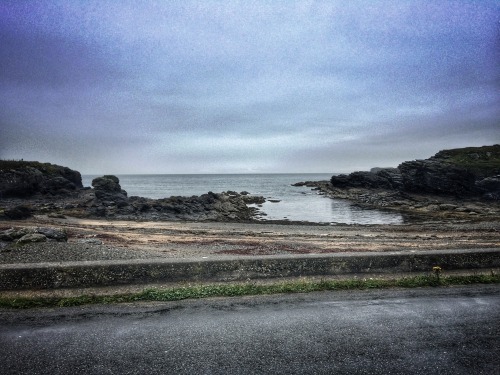
My parents had given me a lift to the start, and were picking me up from Chepstow at the finish. The car had been packed late the night before, and we’d set off at 4am to get to South Stack as early as possible. In my rush to pack the car, I’d forgot one thing - my small mini-pump. My 28mm Continental tyres are too big to drop out of the frame without uninflating them by half, so when I placed the wheel back into the frame after arriving at the start and reached for my non-existent pump, I was a bit concerned.
It was OK however; I’d brought a Co2 inflater and 3 cartridges to use. So, I screwed a cartridge into the spring-loaded inflator and in turn the inflator onto the tyre and.. nothing. The valve in the inflator wouldn’t open. I tried with all the force my puny fingers would muster, but still nothing. Fuck. We’ve driven 165 miles to the start and I can’t inflate my fucking tyre. I took the inflator off, unscrewed the canister slightly and lost all air out of it. One canister down, two left. I did the only thing I could do to try and rectify the situation; I literally took a big rock and smashed it again the side of the inflater. It budged, slightly, so I hit it again. This time, whatever force was holding the valve closed abated and I could rotate the head and open the valve! Canister in, onto the tyre valve and thankfully a fully inflated tyre! Right, I’m only 35 minutes late, time to get a move on.
I left South Stack and headed for the first milestone, the Menai Bridge. Within 5 miles the drizzle that had accompanied our drive to the start turned into rain, and I had to unpack my waterproof. I really don’t mind cycling in the rain - it’s not pleasant, but once you get going and your body warms I find I forget about it. This was definitely the case approaching Menai Bridge, with fantastic scenery and the backdrop of the bridge across The Swellies. I stopped for a quick obligatory photo and pushed on towards Beddgelert, my first planned food stop of the day.



The road to Beddgelert started to undulate, with the approach to Llyn Cwellyn on some of the smoothest and flowing roads in North Wales a highlight. It was at this time I started to see the peak of Snowdon through the dissipating cloud cover.
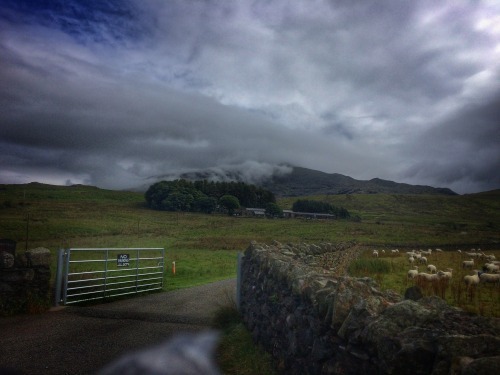
The descent into Beddgelert was awesome, and I met a few other cyclists out on a morning run into town for coffee. From the look on their faces when I told them of my plan, they thought I was mad, but could still appreciate the desire to see Wales in its entirety.
Parting ways just after Beddgelert, I picked my way via a series of B roads towards Harlech on the coast. Passing Fford Pen Llech and not turning left to tackle the 35-40% grade brute drove a pang of guilt inside, but I resisted and instead focused on the bigger picture. It may have been small, but with many mountains to come and only around 50 miles in the legs, I needed to stay as fresh as possible.
On my way to Barmouth I stopped at my Grandads house near Tal-y-bont. It was a great place for my second break, and a decent cup of coffee and a jam filled bagel sorted me out for the next stretch to Machynlleth. It was also a great opportunity to lose the arm and knee warmers, as the temperature had risen nicely, with no rain or clouds around.
The descent into Barmouth was fantastic, and arriving into the town during a water festival was even better. I pushed on through the town, and chose to ride over Barmouth Bridge to the other side of the estuary. The wooden slats of the bridge made the ride akin to riding over cobbles; I’m glad I run 28mm tyres on the bike at this point!

Leaving the bridge and turning right, I start a very pleasant ascent of the coastal road that heads toward Aberdyfi. The gradient is very steady, never rising above 6 or so %, and despite a slight headwind, the weather affords a great view back to Barmouth and the bridge.
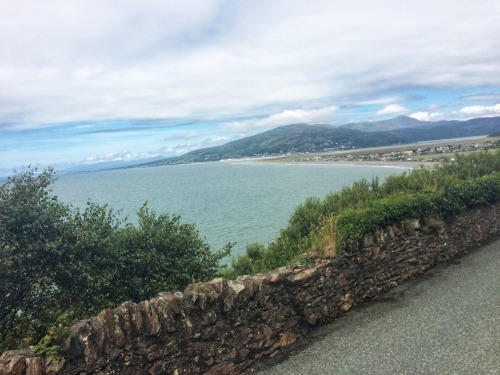
I continue upwards and around the coast for a few miles before a steady descent past a cafe serving ice cream, and have my first low point of the day. With a combination of only covering 80 miles so far, and another 130 or so to go, I felt more than a bit behind schedule. Also, out of Machynlleth I knew the climbing would become serious, and progress slow even more. Still, moaning about it gets you nowhere so I pushed on.
Aberdyfi in the sunshine is beautiful. Seriously. I arrived there just after midday and I could have been in the Bahamas. The sea was crystal clear, blue and it was warm! My mood lifted somewhat, I stopped to take a picture on the way out of town, and pressed on Eastward.

Approaching Mach, I decided to make it my first main stop of the day and have some lunch. Mountains and steep climbs ahead, I fuelled up on another bagel and an energy bar, and took 10 minutes to rest. Whilst difficult, this was the part I was most looking forward to; mountains and climbing.
Part 2 - 14:00 - Machynlleth Mountain Road
I set off from Mach, and headed straight onto the mountain road signposted Dylife. The climb started quickly, and I was soon settled into a comfortable power I knew I could sustain. Slowly lanes gave way to more open areas of the mountainside, and with the sun shining brightly, made for a very warm climb. Approaching what I thought was the summit, the climb grows fairly steep; my Garmin’s elevation profile had been playing up a bit so when I rounded a corner and realised I was nowhere near the top, I wasn’t surprised. What did surprise me however, was how steep the climb was getting. I’m sure when I planned the route I looked at this climb and thought it would be fairly steady; I was wrong!
I pushed on, slightly over-power and overheating, trying to concentrate on my breathing and the magnificent view that was opening out in every direction. Heading over the top and on to Staylittle, I slowed right down and appreciated my surroundings; once again, Wales had delivered. The reservoirs at Staylittle are magnificent!
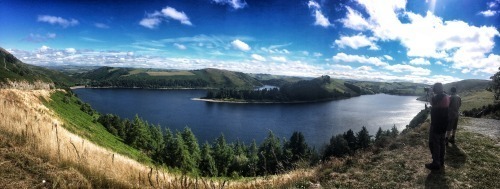
I stopped at a layby, and spoke to a couple of chaps riding motorbikes; I overheard one talking about my bike and saying something along the lines of “but with those tyres and a light bike cycling is pretty easy”. I laughed and couldn’t help myself, and so struck up a conversation about where they were going. Turns out they had just ridden their bikes down from Bangor, and were too heading for Chepstow. When I told them I was doing the same, but had cycled from South Stack, they were very confused. A non-cyclists view of long-distance cycling always makes me laugh; some don’t understand how, or what 125, 150 or 200 miles means to us, but most just look confused as to why we would do it. “Because I can” is usually my answer.
After Staylittle, the mountain road doesn’t really ease that much; the lumps and bumps continue, some fairly steep and a bit of a grind running a 28t cassette. Still, the surface was great, and the going fairly quick most of the way to Llanidloes, and further to Rhayader.
I stopped once more at Rhayader for food and a coffee, and found myself in the middle of a local 'treasure hunt’ style event. I have no idea what they were looking for, but they all seemed very interested in a notice board next to a disabled toilet, with many people pulling their cars up to the board, making notes and then driving off. Weirdos.
Fed and refuelled, I set off from Rhayader for the next part of the journey. I knew it would be pretty flat from Rhayader to Talgarth, as to save some time I’d routed along a couple of main roads in favour of an even longer trip. At this point I was glad of the clip on aero bars for another position!
Part 3 - 17:30 - A Time-trial of Sorts
I left Rhayader and directly turned South for Builth Wells on the A470. I wanted to try and make up a bit of time as I’d been a bit lazy so far, and had more quick breaks than I would have liked. It’s not that I was precious about time (other than the lift back from Chepstow), but I was worried about my legs starting to feel heavy if I rested too much. Dead legs = not much fun considering the climbs of Hay Bluff and beyond.
Despite the time, the road was fairly quiet of traffic and a great surface - I tucked in on the aero bars and managed to maintain a decent power and speed, arriving into Builth Wells quickly. I think I managed the 13 miles between the two towns in around 35 minutes, which I didn’t think was too bad of a pace after 155 miles in the legs!
There’s a lot to be said about using comfortable aero bars in this kind of long-distance discipline. I’d seen plenty of pictures and read accounts of other long distance cyclists using them to great effect in events (just take a look at the riders competing in the TCR for the number using aero bars!), but didn’t appreciate the comfort of having another position for long days in the saddle.
The road out of Builth Wells again started to get a bit lumpy, but fairly fast flowing. I chose to use the B-road that runs along side the A470 to keep the route as quiet as possible - I’m glad I did, as the scenery was once again amazing. The albeit smaller valleys, and plenty of them, carved by the many rivers and streams made for an awesome backdrop to the fading afternoon light.
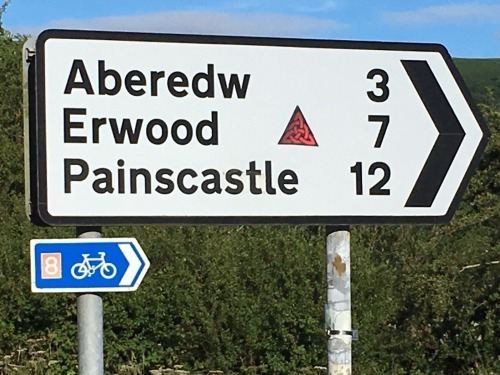
On the way into Talgarth, I was greeted with a very familiar view; Hay Bluff.
Having recently completed an Everesting on the Northern (main) road up the Gospel Pass, I knew this area well. I’d spent nearly 20 hours climbing and descending the pass in June, over what was to be the hottest day of the year, and actually loved every minute of it. The prospect of climbing up Hay Bluff from the Talgarth side was energising, despite the fatigue building in my legs.
Turning South out of Talgarth onto the A479, the climb starts immediately. At a very pleasant average gradient of around 4%, this turned out to be one of my favourite climbs of the day. I’m not averse to steeper climbs, but the A479 climb let me measure my effort comfortably, and leave plenty in the tank towards the top to push on. It was cool seeing Hay Bluff from the West side too - the A479 climb winds it’s way through the ‘cut’ in the bluff before dropping down the other side towards Crickhowell, again with magnificent views of the Brecons off to the right and straight ahead.
On the descent, I started to notice the drop in temperature for the first time, and so pulled over to throw on my knee warmers and arm warmers. It was around 8:30pm and I’d been blessed with most of the day being warm, so couldn’t complain.
Part 4 - 8:30pm - The Home Stretch
Descending out of the Brecons towards Crickhowell, I was again able to make some time up on the fast-flowing A roads. It was at this point, after around 175 miles, I realised I’d made my first route error. I’d planned on dropping South below Crickhowell, using the quieter A4077 to get to Abergavenny, and then again using a quiet B-road out of Aber towards Usk. What actually happened, is my Garmin decided to take me on part of the incredibly busy A40 dual-carriageway for a mile or so. It wouldn’t have been a problem usually, but given it was around the time that many people were travelling back from South Wales to the rest of the country made it incredibly busy, not helped by my fatigue.
I quickly pulled over, re-routed the Garmin somehow (those that use Garmins know how fucking difficult this is!), and managed to find my way back to the road I had intended to be on in the first place. Not a disaster by any means, but still unwelcome after a day in the saddle and a place to be.
I took a quick break in Abergavenny, and used some of the time to check the route of the final 20 miles or so to Chepstow. Happy I’d not cocked up again, I pushed out of Aber on the B-road to Usk. It was dark, the road quiet and surprisingly the temperature started to climb again. Feeling refreshed after my stop in Aber I really enjoyed this section. I’d pretty much ran out of food, but didn’t feel too bad, so knew barring disaster this ride was in the bag.
Out of Usk, I hit what was to be the last climb of the day; the climb from Llangwm to Gaer-Fawr. It was only after cycling up and over this fairly brutish climb, I realised it had been used in the Ras de Cymru in 2014, and I can see why. Whilst not overly long, the climb has some steeper pitches that made it ‘interesting’ after just clocking 200 miles, and not much fuel in my body! At 4.5 miles and around 800ft elevation gain, at any other time I would have enjoyed it. But at that moment, I just wanted it done with. Reaching the top, I felt some relief that it was over and I just had the descent to Chepstow to go.
Rolling down the long descent into Chepstow, I reflected on the day’s ride; it had been a great day weather-wise, apart from one mishap, a decent route with a nice mix of quiet B-roads and faster A-roads, but above all, Wales hadn’t disappointed in the scenery. North Wales with it’s large mountains, Mid Wales and the steep valleys and many reservoirs, and finally South Wales and the pleasant steady-grade climbs that allow you to take in your surroundings whilst keeping a decent pace.
I’d thoroughly recommend the route to anyone looking to experience a sample of what Wales has to offer; the ride wasn’t overly taxing, but enough of a challenge to make some of the tougher parts worthwhile.
Finally, arriving into Chepstow, I met up with my parents and attempted to get a picture of the castle. It was dark, I was getting cold, my first picture was very blurry and so I couldn’t be bothered to take another. So I took a picture of a signpost and that had to do.
1 note
·
View note
Text
Wetlands, Dunes, Snow and Sun: Week 3, France/Spain
George, Suzi the van and I have had a jam-packed seven days. Now across the Spanish border, I look back at the diverse landscapes we’ve traversed and the things we’ve been up to.

It’s amazing what you can squeeze into a week when you’re in a van. The freedom afforded by having a home on wheels means that you pass through so many different landscapes in what is often a short amount of time, and this last week has really been a testament to that. From natural to man-made, cold to hot, coastal to mountainous, our surroundings have provided endless new things to see and do. That said, we’re still learning to balance working and doing life admin with exploring, and at times it’s hard to resist the temptation just to spend every day out and about, carefree.
We’ve found that splitting days up so that a portion is spent editing videos and doing ‘housework’ still often means we get time to go and do something fun, whether that be wandering a city, chilling at a cafe, going for a hike or even a swim.
Going through the Pyrenees was definitely a highlight for the two of us this week. It was also symbolic because it marked our crossing into another country, our first since leaving England and hopefully one of many.
That experience of driving across the mountains really got me thinking about borders and how different places transition into one another. We think of different countries such as France and Spain as distinct by the very fact that they’re different countries. And yet, what we observed was an incremental change between major cities, to towns, and then villages at the foot of the mountains - which was mirrored over the border. A border which when crossing it, seems so arbitrary. The French and Spanish villages in the Pyrenees have far more in common with one another than they do with the capital cities of their own countries!

(images) Snowy scenes from Col du Portalet in the Pyrenees.
An overland trip like this couldn’t be more different from a traditional holiday where you fly in and out of the same place, for the very reason that overlanding reveals borders and in-between places, and nuances and incremental changes within a country.
I’m really starting to have to consciously keep tabs of what we’ve been up to in order to write these blog posts. Analysis and list-making have always been my thing, but I sort of combine digital discipline with analogue chaos! So I have a Google MyMaps document where I pin each overnight location we stay at; I add pins to our Polarsteps page in each of the interesting places we visit; I upload photos to both my personal account and our shared account Broaden; I keep my own personal handwritten diary; plus I have a notebook scribbled with lists and bullet points too! So these blog posts are my own way of pulling all those inputs together. Writing a blog has also become a cathartic process for me to review the (sometimes overwhelming) influx of things we’ve seen and done, and to dig deeper into how those experiences made us feel.
Reflection enriches experiences.
The week started with a final day in the town of Coutras, as I reflected on in last week’s blog post. Coutras was the ideal place to head into Bordeaux from, as it was less than an hour’s drive away. So we got up nice and early (for once!), with a packed lunch and cameras charged, and drove into Bordeaux. The parking gods smiled down on us that day, as we found a free all-day parking spot in a nice neighbourhood just 30 minutes walk from the city centre. It was also gloriously sunny, which was perfect for what we had planned: filming an introductory video to our documentary channel, Broaden.
Once in Bordeaux, I was really impressed by how much cycling and walking infrastructure there was, and how integrated it seemed to be with public transport. With cars diverted along key routes, streets were generally left feeling spacious and peaceful (at least compared with the UK and Australia), and especially along the waterfront which featured wildflower planting, a wide promenade, and grassy tram track. People sat outside cafes and on benches, other folk walked, jogged and sprinted, others pushed pushchairs, and some rollerbladed and skateboarded too. As Jane Jacobs would call it, the “sidewalk ballet” was on display.
We were really taken by Bordeaux, and happy to have chosen it as the setting for our next video. I’m even getting used to walking around cities with a tripod and big camera bag!

(images, left to right) Grassy tram tracks in Bordeaux, George filming our latest video, and the Glosse Cloche, a 7.75-ton 18th-century bell within Bordeaux’s old city walls.
Filled up with coffee, cake, and cannelés (a local sweet treat), we were happy with the footage we’d shot and said goodbye to Bordeaux. The city’s chilled-out and welcoming vibe did slightly change as we walked back to the van, however. It’s not as though anything explicit happened, but we emerged from the bubble of the central tourist area and were confronted by busier streets with homeless people and rowdy crowds - subtle things which make you scurry along quicker or keep an eye on your belongings. It reminded me that we only ever see a fraction of a place and make our assumptions about it biased by things like the weather and our first experience of it. Perhaps Bordeaux has its darker sides and downsides too…
On the drive out of Bordeaux, we found a service station with free water refills and even free hot showers! We found it via Park4Night, an online community and a resource we literally couldn’t live without. It still feels a bit weird taking free stuff from places, but given that the infrastructure is there, I have to remind myself that attitudes towards campers and caravanners in mainland Europe are different and more welcoming than I’m used to.
Using Park4Night again, we found a spot to stay overnight in La Teich. I didn’t know much about the place, and must admit we didn’t feel completely comfortable as we arrived there in the dark. But our fears were eliminated the next day as the sun rose and we discovered we were basically in the middle of a picturesque nature reserve! We spent the day in Suzi, and I wrote my blog post (I was a bit behind last week) while George edited his mammoth documentary about the Mont Blanc ultramarathon. It was only in the evening when we went for a walk that we realised the scale and beauty of the coastal wetlands that we had parked next to.

(images) Incredible views as we wandered the wetlands of the Réserve Ornithologique Du Teich.
As the sun set over the wetlands, we wandered along sandy paths with grassy embankments, accompanied by the sights and sounds of abundant wildlife - made all the more breathtaking because it was so unexpected.
The next day, after a morning of life admin we visited the Dune du Pilat. I think we both thought that we’d just park up on the side of a road and see a big sand dune next to us, but it was a lot more of a tourist destination than we expected! That said, Europe’s tallest sand dune didn’t disappoint, and at 100m tall and 500m wide, it pretty much came with a free workout just getting up the damn thing. Vast, scaleless, shifting shapes of sand continued as far as the eye could see, stretching up towards the sky and sloping down towards the ocean. Of course, I was desperate for another swim and even convinced George to come in for a sea dip.

(images, left to right) The Dune du Pilat, and an ocean swim in the Bay of Biscay at the bottom of the dune.
Refreshed by an ocean swim and a sandy workout, we drove for two hours southbound, and stayed the night in Pomarez. With free water and electrical hookup, it made for a good spot to do more work, though we were a bit conflicted by the fact we were parked next to the ‘Arena’, basically a bull-fighting ring (shocking that this tradition still continues). That said, the presence of bullfighting in this nondescript French village was a good indication that we were near the Spanish border, and we were pretty excited to be travelling onwards into Spain, a country both George and I are really fond of.
We left Pomarez and got to the Pyrenees that night as the light faded. We were both really keen for doing a big hike and so I’d found a 20km loop track online that started near the village of Gabas. However, once there, the access road was closed off due to risk of avalanches so we continued on to Lac du Fabrèges - a slightly less secluded spot than we’d wanted but still a stunning setting next to a huge man-made lake. What’s more, we were surrounded by snow-capped mountains which got George rather excited, especially as we’d aborted our trip to the Alps a fortnight before.
The next morning I got my third wild swim of the trip in the bag, and possibly my most stunning setting to date: icy turquoise waters framed by craggy mountains and snow off in the distance.

(image) An icy wild swim at Lac du Fabrèges.
We passed through Col du Portalet, a ski village on the French-Spanish border where we’d seen there were some walks online. During the ascent, we realised we’d been somewhat naive about the amount of snow there might be - once we got to the top our entire surroundings were blanketed in snow and everyone else in the carpark was putting on skis or cramp-ons! So instead, we visited the duty-free shop and bagged some cheap, cheap wine, before heading down the Spanish side of the mountain and on the hunt for a hike.
The hike we eventually found was exactly what we were looking for. Starting from the town of Escarillas, the steep ascent took us along a rocky path up the side of a valley, at times through wooded patches and other times opening out to vast vistas of the surrounding peaks. We only saw a handful of other walkers and it felt like such an honour to have this majestic setting all to ourselves. Nearing the top, we saw that beyond the lake there was a considerable amount of snow and the path was no longer distinguishable, and although excited by the thought of charging ahead up a snowy mountain, we decided instead to walk the perimeter of the frozen lake before heading back down the way we came.

(images) Our hike from Escarrilla up to Embalse de Escarra.
All in all, it was a brilliant 13km walk, though we were certainly over-prepared in terms of clothing, and didn’t touch the extra jackets, waterproofs and even headtorches that we carried in our bags! In fact, it was so warm for February that the weather felt rather alarming, and it confirmed what we’d seen and heard: we’d seen plenty of ski lifts closed and ski runs with no snow, and been told that climate change is noticeable in the region through this mild winter.
There’s no doubt we’ll continue to see the effects of climate change on our travels. As we observe unusually high temperatures here in Spain whilst watching flooding in Hebden Bridge back home from afar, it’s hard to come to terms with the idea that freak weather events will only continue. I only hope that we can find people and initiatives looking to tackle them, who we can support and celebrate through videography.
Sunday night saw us leave the Pyrnees and head south. Suzi struggled up the highway towards Huesca, which was undoubtedly the longest continuous incline we’ve taken her up. It reaffirmed the importance of getting her engine looked at, and so finding a garage in Spain is now a key priority.
Once in Huesca, we rounded the week off with a really relaxed day in this charming town. The sun was shining, the doors of the van were flung open, and we even befriended another van-dweller, a lovely Scotsman called Dominic and his affectionate Labrador, Bolacha (that’s ‘biscuit’ in Portuguese!). George got some more editing done, whilst I polished our boots, cleaned the van, and even made a collage.

(image) ‘Double Gaze’, my latest collage for Analogue Bryony and the first created in the van.
With one eye on the mountains to the north, and one eye to the rest of Spain to the south, bursting with adventures yet to be had, I am so very grateful.
#Traveldiaries#suzithevan#toyotahiace#overlandadventures#digitalnomads#bryonyandgeorge#vanlife#hiacevan#lifethroughalens#vanliving#consciouscommunity
0 notes
Text
The 10 best Christmas markets in Europe

Christmas in Europe feels different and special. There are few cities that have Christmas markets and that delight both large and small. If you are going to travel to the Old Continent at this time of the year, a recommendation is to create a road map to visit various spots in Europe, because in each country the Christmas spirit is lived differently. If you are thinking of enjoying different parties this December, discover the 10 best Christmas markets in Europe.
1. Colmar, France

The Alsace region occupies the northeast of the country. Among all the Christmas markets that we can find in France, that of Colmar stands out as one of the best known. And not only in the country, but it has also become so famous, that it already has a well-deserved position in the lists of the most beautiful Christmas markets in all of Europe. Colmar has a curiosity that makes it a special city, to the west with Germany, there are few German customs that have inherited its inhabitants, these are even more abundant than Latin.
Colmar is one of the Christmas cities that is most worth visiting. In addition, it is one of the most charming villages in France and that transports us to those stories we read as children. You will not be able to resist the smells and flavors of the Christmas market in Colmar. Its half-timbered houses, which already attract attention by themselves, are decorated with colored lights to shelter the beautiful market that makes its way to its feet. Without a doubt, the perfect place to enjoy the mulled wine and other delights of the area in the street.
2. Zagreb, Croatia

Traveling to Croatia at Christmas is one of those things you should do at least once in your life. The Zagreb Christmas market stands out for being one of the most recognized, becoming one of the best Christmas markets, receiving even an award that accredits it for three consecutive years. Although we normally connect the country with long beaches and very marked coastal tourism, we cannot forget the city in winter.
Zagreb is a capital that stands out for maintaining a very strong European center style. This makes Christmas markets one of their best-kept treasures and that they are enjoyed to the fullest. This holiday season is where we will find a greater number of tourists, which has made its Christmas market become one of the most important in Europe. As a curiosity, we must bear in mind that it is not just one, but we can find a market in each tourist spot in the city.
3. Nuremberg, Germany

If we talk about the most beautiful cities in Germany at Christmas, Nuremberg should be at the top of the list. Its most important Christmas market is the one located in Market Square. As a curiosity, everything is so beautiful and every detail is taken care of perfectly, as there are prizes for the best wooden stalls. This makes it one of the most careful Christmas markets in Europe and that receives more visitors each year.
There are a few things that we can find in this particular market. Do you feel like trying the real gingerbread? Do you prefer to buy handmade toys or various pieces of decoration for this Christmas? Everything and more is what you can find among its alleyways. When you finish taking the walk through the whole network of bungalows, do not forget to stop and taste the delicious German sausages that you can find in many stalls, bathing them with a comforting hot wine. You will want to come back!
4. Bolzano, Italy

Bolzano is an alpine town in Italy that has a marked Christmas tradition. If we talk about the best Christmas markets in Europe, there is no doubt that this Italian town must be present on the list. This romantic medieval settlement already attracts attention by itself. However, if we add to its natural charm how it is decorated when Christmas approaches, we will achieve an explosive result.
Two markets are those that meet in this town every Christmas. One is the largest, the other is the oldest. That is, both stand out equally. Although enjoying a beautiful snowy Christmas is a strange thing in the Italian country, thanks to its Alpine characteristic, Bolzano is one of those villages where we can enjoy the beautiful snowy peaks while we impregnate the best Christmas spirit. One of the cities to visit in Europe this Christmas to enjoy something different.
5. Strasbourg, France

If we talk about a Christmas city par excellence in Europe that is Strasbourg. Strasbourg has a Christmas market that stands out above the rest and where you can breathe an atmosphere full of romanticism. The entire city turns over during the last month of the year to welcome and unite through its narrow streets full of charm an impressive Christmas market that extends throughout the center, delighting visitors and locals alike.
One of the things you should do yes or yes if you visit the Christmas market in Strasbourg is to try their delicious mulled wine. It will help you get warm and, if you taste it in the enclave of the old square, it will automatically transport you to another older time. We can not forget the delicious crêpes, which here we can taste both sweet and savory and accompanied by other rich products such as jam or fresh fruits.
6. Stockholm, Sweden

Stockholm at Christmas is a city that develops and acquires a special charm. The city of Stockholm in December gives its best, especially in the old part of the capital. The streets decorated with hundreds of lights, the Christmas spirit, the garlands that crown the establishments, etc. they confer a romanticism difficult to match at other times of the year.
The one in the capital of Sweden is one of the Christmas markets in Europe that stand out most thanks to its already extensive experience since it has been active since 1914. Here we can find all kinds of Christmas ornaments, as well as various wooden toys made to hand and endless events and attractions with which to live to the fullest one of the most important parties in the Old Continent. Its marked Christmas spirit, its traditions, and its romanticism make Stockholm one of the best places to spend Christmas in Europe.
7. Tallinn, Estonia

One of the things you should keep in mind if you are going to travel to Tallinn at Christmas is that, after living the first-person experience, you will most likely want to repeat at any other time in your life. If the city already has a special charm throughout the year, it is at Christmas time where it makes a display of all that capacity to capture the attention of visitors and locals that knows how to take advantage of it.
This Christmas market is installed in the city of Tallinn approximately one month before the holidays so that anyone who is here can enjoy it or come expressly to admire it. Christmas sweets stand out in the stalls. However, surely what he manages to fall in love with, especially the little ones, is the small zoo that rides in it. Here we can enjoy reindeer and geese and the occasional animal. In addition, we will also have fun thanks to the various dances and performances. Without a doubt, a different Christmas that you will not forget.
8. London, England

If we make a list, London is also one of those cities that is worth visiting at Christmas. It is true that the English capital deserves a visit at any time of the year, but in December it is when it is more beautiful thanks to the decorations, lights and all the Christmas charm. London has the most impressive Christmas markets in Europe. The most advisable thing is to visit the Winter Wonderland, but in the city, you can find many more since the month of November.
In Trafalgar Square, we can enjoy the fir that the Norwegians give each year to the English people as thanks for their participation in World War II. There are few streets that are closed to traffic on these dates to house the various markets that meet in the center of the capital. To enjoy all the charms of these markets, the idea is to make a route highlighting the most important tourist points of the city.
9. Copenhagen, Denmark

Copenhagen at Christmas has that "I don't know what" that fills it with charm. It already stands out for being one of the happiest cities in the world. Therefore, when the Christmas spirit reaches its streets we cannot imagine anything better. In addition to the fact that its Christmas markets are among the most important in Europe, we cannot forget that this time of year is ideal for visiting one of the European cities that receives more tourists every year.
In addition to the spectacular Tivoli Amusement Park, the stores also want to take advantage of and capture the attention of visitors and locals by putting in their shop windows a succulent and elegant Christmas decoration. Buy, eat, rest. All this and much more we can do at this time of year if we get lost between the streets of the city. Lights, garlands and endless Christmas decorations will welcome us in each of the parts of Copenhagen inviting us to celebrate with the Danes one of their favorite times.
10. Zurich, Switzerland

If we talk about spending a Christmas in Switzerland we cannot prevent the mind from evoking how beautiful the city of Zurich is at Christmas. There are different Christmas markets that are distributed throughout the city center, so it is good to take a guide to not miss anything. In the train station and in front of the Opera building is where we find Rapperswil-Jona, one of the largest. Here we can get lost, try different types of food and, of course, buy any of the things we find and get our attention.
Those in Zurich are one of the most important Christmas markets in Switzerland, which makes it worthwhile to enjoy every step you take in the city. If you have finished your purchases at the Opera Market, you can finish a beautiful day full of meaning ice skating on the track that is right next door. Undoubtedly, a different way to enjoy Christmas that stands out above other European corners and not only for the markets, because there are other related attractions in the city such as the Santa Claus train. Do we go for a walk?
Read the full article
0 notes
Text
My 10 day Egypt Journey

Traveling to Egypt was a dream come true for me. I have been fascinated by ancient Egypt since I was a young girl and this fascination led into my adult years with more in depth studies into the awesome ancient sites. When the opportunity came to me to travel with a small group of 6 other highly intentional people with similar interests, I made it happen- in spite of the not so great financial situation I was in- and I am SO gratefulfor the support I received to help make it happen for me. In this blog I will share about the amazing places I visited in a VERY full 10 days and I will offer my own reflections about the experiences as well as some travel tip/advice for anyone else interested in making this “pilgrimage.” I say pilgrimage because we were venturing with intentions for connecting to the energies of the places, feeling a remembrance in our souls for these ancient lands. I will first say that having a guide for our trip was *essential*- it just wold not have been possible- A guide is needed for many reasons. Egypt is not the easiest place to navigate and travel solo- to have a guide that knows the language, culture and how to negotiate with officials in absolutely necessary. Our guide was so wonderful, just reach out if you are interested in hiring him! So let’s get started!

My journey began actually in the country of Turkey. This was also a dream come true- literally. I have had a number of dreams related to Turkey- involving certain names and places and also a deep sense of remembrance. So if you want to skip straight to Egypt scroll down a little bit.
(*Travel side note: I had frequent flyer miles through United Airlines that would cover most of my travels but for some reason I didn’t have a enough for round trip to Cairo and back. So I figured out a way to utilize my miles to take me to Izmir, Turkey and then from Frankfurt, Germany all the way home and so all I had to to do was buy 2 connecting flights: from Izmir to Cairo and from Cairo to Frankfurt- which cost around $550 for both, yet allowed me two extra little adventures with some dear friends living in this places- Plus- WHAY NOT since I’m going all the way out there~.)
TURKEY~ I arrived in Izmir, a city of over 4 miliion, to open the arms of my auntie Julianne, who now lives there as music teacher at an international school. She absolutely loves it there and I can see why. She lives in a very bustling part of the city called Alcancak and has a cute apartment that has a rooftop-soon to be garden- that overlooks the city. Below on the narrow streets are many restaurants and clubs with delicious Aegean/Mediterranean/Middle eastern foods and music. As well as being a teacher, she sings in a band, and most of her friends there are musicians. The very first night after getting in we went out to see one of her friend’s bands and met up with her other good friend, Mira, who had just gotten into town from Lebanon. I won’t go too into detail of my İzmir adventures but just provide some highlights: exploring the old and colorful places of Izmir, visiting a coastal village & getting to swim in the Aegean sea (literal dream come true) at a lovely beach and also going to visit the ancient city of Ephesus (Efes). (See photos below) I would absolutely love to return to Turkey to explore more of this country that has very ancient roots- of which I am quite fascinated by what is known of Anatolian and Thracian cultures. And the site of Göbekli Tepe dates back perhaps over 10,000 years ago, and is evidence of an advanced civilization- an inconvenient anomaly for many historians. One of the aspects I love most about traveling is connecting with other human beings on the way. The language barrier doesn’t even really exist, especially with “google translator!.”




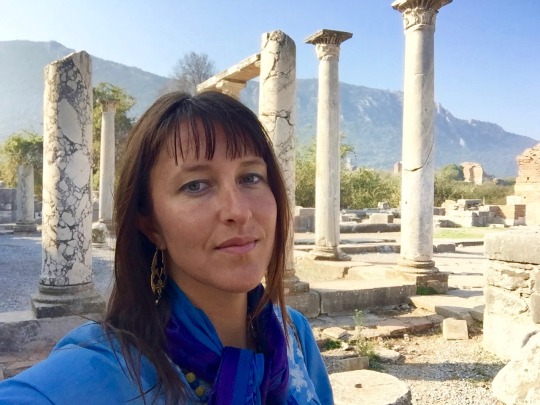

Ok! now let’s get on with the Egypt journey shall we?!
DAY 1- arrival in Egypt~
I arrived in Cairo around 10:30 pm and was greeted by someone holding a sign with my name on it when I got off the plane, who quickly escorted me through customs and helped me through purchasing the Visa on arrival (which was $25). That was all very helpful. I’ll just tell you right now that to have an organizer for our group made our travels SO easeful and smooth and I highly recommend it, ESPECIALLY if you want to travel with a small group of friends. AND if you would like me to connect you with our amazing organizer and/or guide reach out and let me know. I was then greeted at the baggage claim area by our official organizer, Ihab, who informed me of the current wild weather conditions that turned Cairo into a chaotic traffic jam with floods and accidents. He showed me to my private vehicle and driver that would take me to my hotel- The Mena House (the historic hotel that is located right next to the great pyramids of Giza). What would have been a 30 minute drive was more like and hour and a half with all the crazy traffic. I counted about 8 big accidents with car pile-ups and gratefully I arrived to the hotel safely and was shown to my room to rest. I remember getting my first glimpse of silouettes of the pyramids while approaching the hotel and it sent electricity through my body. I was really here! My room mate Tara arrived around 2 am along with the rest of the gang. And we were up early for breakfast to begin our first day!
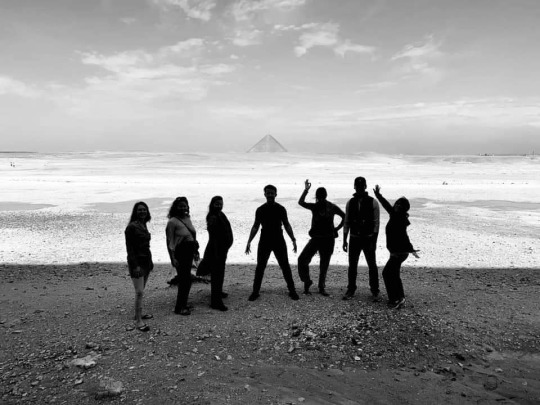
DAY 2- GIZA / SAKKARA / DAHSHUR - (accomodations at the Marriot Mena House- Cairo’s oldest hotel, situated right next to the pyramids!)
After our breakfast we were off on our first adventure, to drive about 40 km south of Cairo into the desert to the pyramid complex of Dahshur- the largest of which is known as the “bent pyramid.”The real name of this pyramid is “Sneferu is shining in the south” (or “Sneferu is shining”) because it was covered in a polished Tura limestone. It is not exactly known why there was the “bend” in angle of the pyramid. These are some of the oldest pyramids in Egypt, dating back to around 2600 BC. We were able to go inside of the smaller pyramid located behind the “bent” pyramid, which is thought by some to be the pyramid for the pharoah’s wife, although it may have been for more ritual purposes that for an actual burial. Even being inside this small pyramid was impressive in its construction. (good preparation for the following day). It only reopened to the public in July of 2019, having been closed since 1965. I was also able to go inside of the Red Pyramid, which was the first “true” smooth sided pyramid ever built. That is the one seen in the photo above and below, followed by photos of the “Bent” pyramid and its smaller nearby “satellite” pyramid, which we went into. Notice the puddles from the rain!! We felt blessed from the rains, which cleared the air and kept the dust down in the desert!




Seen above is a large altar structure that is on the east side of Sneferu’s “bent” pyramid. It is what is left of the the temple from this pyramid.
We then headed north to Sakkara, to Kind Djoser’s “step pyramid.” This pyramid is actually the oldest pyramid of all. It is believed to have been designed by high priest Imhotep for Pharaoh Djoser. Imhotep is believed to have been Djoser’s chief officials and is a very important person of ancient Egypt. He was eventually deified as the god of medicine and healing, possibly 2000 years following his death. His name translates to “the one who comes in peace.” Although the tomb of Imhotep has not yet been found, it is thought is may lie somewhere in Sakkara. This “step pyramid” of Djoser will be soon opened to the public, and we were blessed to have gotten a small peek at the entrance/bottom of the stairs leading into the pyramid.



After this exploration and feeling a new and growing fascination with Imhotep, we had the opportunity to visit a tomb that was over 5000 years old. Again, we were there all by ourselves and it was really incredible, the amount of artistry that went into this tomb- with multiple rooms, all with intricately carved and painted walls. Afterwards we went to the town of Sakkara to have lunch and then to a place where beautiful rugs are handmade of wool, cotton and silk. I was walking aroung this place with stars in my eyes...and yes I did purchase that special Isis rug!! Side note: When got to Sakkara step pyramid, it was right around lunch time and there was hardly anyone there because of that, which was quite nice to enjoy this place without the hordes of tourists. It pays to have a good and knowledgeable guide.

We finally headed back to our hotel to rest for the following big day.....
DAY 3- We arose very early, to depart around 4:30 am, to the Great Sphinx. The hotel was very close by so it didn’t take long before we were at the gates, and getting through security to be able to have a private two hours with the Sphinx. We arrived and walked quietly under the stars and magical waning crescent moon, to the paws of the Sphinx where we assembled into a circle and Tara led our first group ritual there. We received an anointing and a very special ormus tincture and each had the opportunity to speak our magical words of intention for what we wish to resurrect in our being. As the ritual was completed the first light began to show on the eastern horizon. All was quiet and peaceful until the first rays of light shone upon us all, sealing in the magical essence of which we all imbibed. We walked in wonder around this ancient monument that was carved from the bedrock of this land, perhaps over 10,500 years ago. I could only imagine what life was like on the earth then and how humanity lived. To think that this structure was created that long ago, challenges the the linear technological advancement of humanity and that we are currently the most advanced civilization. What this monument possibly signifies is the last/previous golden age that existed on earth, in which lived people that were highly advanced, with great knowledge of our place in the cosmos. Some may even postulate with good reason that our ancient origins lie somewhere else, not on this earth and that humans received (and possible still do receive) extra-terrestrial technological guidance. The third photo down is a photo I took from between the paws of the great Sphinx, and you can clearly see the constellation of “Orion’s belt,” which is thought by many progressive historians, such as Robert Bauval, to be related to the layout the the three great pyramids on the Giza plateau.
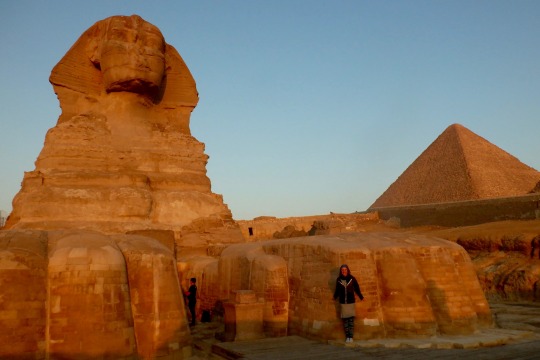


After this magical experience we departed and drove out onto the Giza plateau for a great overview of the pyramids, in the early morning light. It was again, a great time to be there, as it was before anyone was up- no tourists and vendors trying to sell you stuff. It was quiet and peaceful.


Seen above, is a photo of myself with the powerful, beautiful women I was blessed to travel with. Alia: a soon to be mother and awesome music producer and DJ, Kanna: a fully embodied ceremonial healing arts practitioner, Maya: an accomplished life coach & mystery school high priestess and Tara, a songstress, Vedic astrologer and visionary entrepreneur...
In the later afternoon we prepared to visit and enter the great pyramid of Khufu (also known by his Greek name Cheops). He was the successor to his father, King Sneferu. These massive pyramids are made mostly of very large limestone blocks. Within “Khufu’s pyramid” there are 3 chambers, which are made of a dark granite that came from over 500 miles away. The pyramids used to be covered in a smooth white casing of limestone mortar, which must have been quite a sight! The original entrance to this great pyramid is on the north side, about 59 feet above ground level. However, it may have never really been an “entrance” as it was all entirely covered up and it wasn’t until 820 AD, when the Arab Caliph Abdullah Al Manum, in a pursuit of finding tomb treasures busted his way through the pyramid making a tunnel until he accidentally “found” the original tunnel “entrance” and then also discovered the other shaft tunnels leading to the different chambers. Even though this pyramid has been regarded at King Khufu’s tomb, no treasure and no mummies were ever found. Being inside this pyramid I marveled at the advanced architectural engineering required to achieve such exquisite and perfect construction.
Our group had an exclusive, private 2 hours in this great pyramid. We entered at sunset from this roughly hewn tunnel below and to the right of the true and original entrance. Once through that we reached the original shaft which went downward until it met another shaft leading upwards (the shaft does continue going down to a lower chamber which we did not go to). It was quite the climb up the steep, narrow and remarkably high shaft (see photo). The first and middle chamber that you reach would be the Queen’s chamber, however we kept going up to go to the King’s chamber first. Finally we were at the top of the shaft and then had to hunch over low to get through a short distance of perfectly rectangular tunnel and then we entered the King’s chamber, a box like room containing an empty and partially broken granite sarcophagus. I was in awe. The acoustics in the room were amazing, every sound echoing and resonating and then perfectly resolving to silence. We assembled into our guided formation and began our ritual, guided by Alia and Shane. I won’t go into too much detail about it but I will share that we each had the opportunity to give/receive healing hands and toning, each taking our turns to lay down in the middle. A few of us, including myself, took the opportunity to lay within the sarcophagus for a some moments. My intention was to let die any aspects in my psyche that impede my evolution and highest purpose...and to resurrect myself newly empowered.


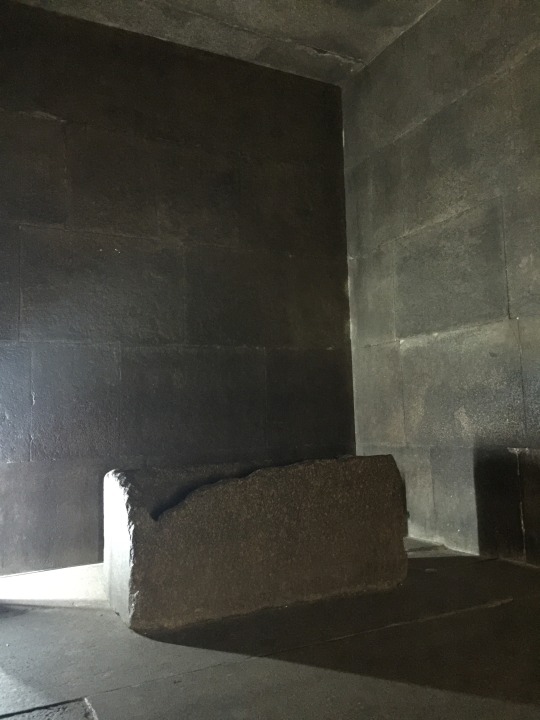
Most of our time was in the King’s chamber, but we also got to go inside the Queen’s chamber, which was smaller and differently shaped, more chapel like. Upon exiting it was rather surreal, there were many people waiting to get inside- it was a whole film crew, and one guy dressed as Napolean Bonaparte- to play out the tale of his time alone in the great pyramid. Thankfully our trusty guides prevented this film crew from barging in and disturbing our time, which they were definitely ready to do!
Day4-The next morning we were up bright and early and off to the airport to take a short flight 425 miles south to Aswan where we would be boarding on the Mayfair Nile cruise. Our group just happened to be the first people on board the ship so we had a wonderful relaxing time dropping in and relaxing. Then that afternoon we went to Philae, Temple of Isis. We took a quick shuttle to a little dock and then a motor boat ride to the “island” of Philae, where the temple is. This island is actually located in the reservoir of Aswan’s low dam, which was constructed in 1902. This caused the waters to rise and the Temple of Isis, in its original location, began to get inundated with the rising waters. In 1970 the it was decided that the temple would be moved to higher land so that it could be preserved for future generations. This process took 10 years and was finally re-opened in 1980. Its incredible to think that this entire temple was moved stone by stone. The temple is very beautiful and the energy is enhanced by the surrounding water. This area is/was held very sacred by the ancient Egyptians and Nubians. Just across the waters you can see where the temple once was, on a cataract of the Nile River. This area is also believed to be the burial place of Osiris. The temple’s construction began sometime around 350 BCE, yet evidence suggests that temples honoring Isis existed in this area as early as the 6th century BCE.


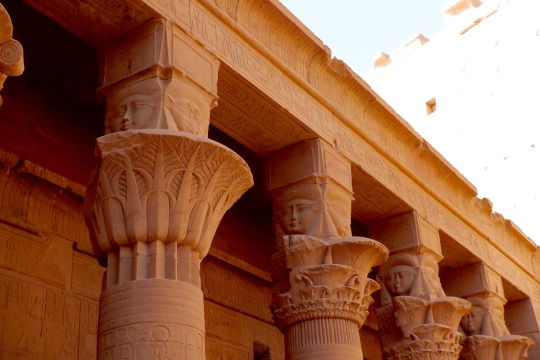



After walking around the temple complex and learning about it all from our guide I found a place where I would lead our group’s ritual. I chose a small side room that had at one time been either a healing room. I felt that in this small room we would be undisturbed and (hopefully) be unnoticed by the guards, as any form of meditation or ritual is forbidden in Egypt’s ancient sites. Without going into too much of detail of the ritual, I will just say that we each had the opportunity to speak our words of power and healing, with the intention of infusing our every cell of our body with this healing light, calling upon Isis to hear our prayers. Each prayer was sealed with a self anointing of the “sacred communion” blend I brought with me. Fortunately we were able to complete our ritual before the tourist police showed up. We dispersed and still had more time to wander in wonder and revel in the healing energies before departing back to the Mayfair cruise.

Not too surprised that a new song came through that evening on the boat! We had a lovely group dinner back on the ship that night. Every dinner we took the opportunity to check in with each other, and we each had the opportunity to share our feelings/thoughts about the guided intentional inquiries. This definitely helped to keep a conscious and ceremonial container for our group as well as maintaining a sense of harmony and understanding of each other.
Day5-The following day after breakfast we were off early to the Kom Ombo temple, which we were able to walk to from the boat from its new “parked” location. Kom Ombo is a unique temple because it is a double temple, in honor of two different gods: Sobek, the crocodile creation god and Horus, the falcon headed God. These two gods are thought to actually be rivals. The temple has a clear central meridian line that runs through it. It is thought that this temple was once a pilgrimage site for healing and perhaps childbirth as there are sections of this temple dedicated to Hathor (Goddess of fertility and motherhood) and Khonsu (Goddess of the moon). There are fascinating heiroglyphs of women giving birth and of “two spirit” individuals. In the far back walls there are very unique hieroglyphs: very first known representations of precise surgical tools. Some of these tools include suction caps, scalpels, bone saws, dental tools, medicine bottles, forceps, birthing chairs and forceps! After we took as much time as we could feeling the vibes of this interesting temple we did a quick walk through of the crocodile mummy museum close by, before heading back on the ship.
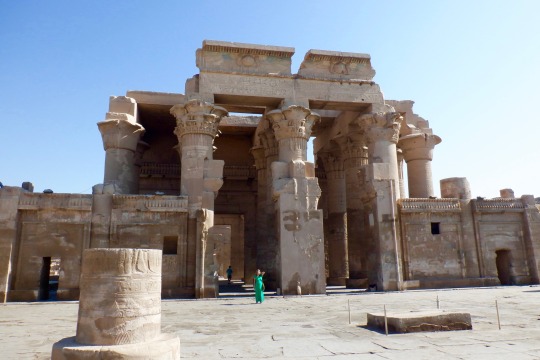
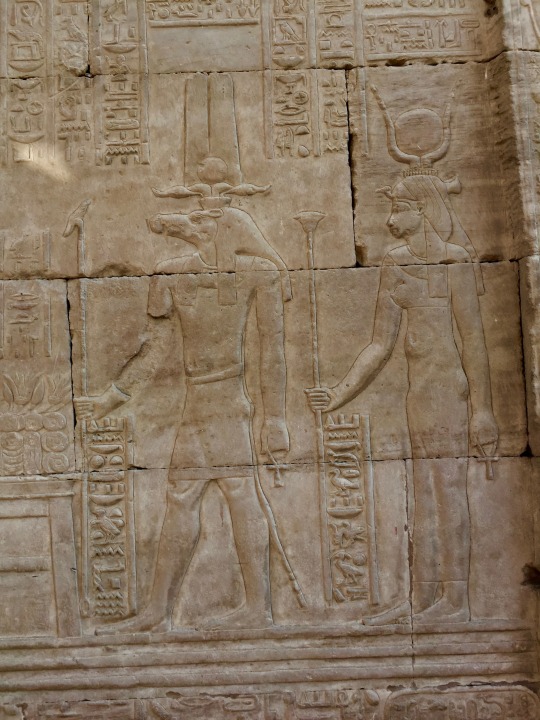

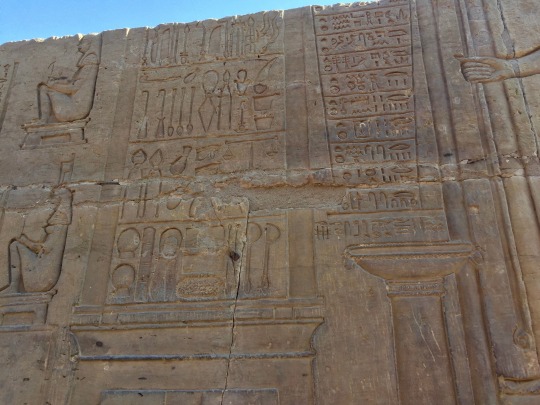

When we got back on the ship we had lunch and it was quite the spread! Very elaborately carved vegetables and delectable platters of food! (see photos below) The ship took off further down the nile and stopped again where we got off again, this time in Edfu. To get to the temple of Edfu, known as the “Horus temple,” we took 10 minute ride in little horse drawn carriages! That was rather fun, and if my mind remembers correctly, I think it was my first time being in a horse drawn carriage! This temple is a very well preserved temple of the ancient world, perhaps due to the fact that until the late 1700′s it was buried in the drifting desert sands and silt from the Nile River. Excavation projects to uncover this temple began in the 1860′s. What is unique about this temple is it’s art, depicting the epic battle between Horus and Set (Osiris’s brother) as well as many different chamber rooms to many different gods. The central chamber to Horus / “holy of holies” holds a black granite shrine where the golden statue of Horus once stood. In front of that is a replica of the wooden barque (the original can be seen at the Louvre in Paris), which would have held the golden statue of Hathor on festivals and during processions. This temple had a lot to see in each room, it was quite astounding. What was hard to ignore however was how many of the faces of the gods and goddess where chipped away, from when Christianity was on the rise and all things deemed “pagan” were promoted to be destroyed.







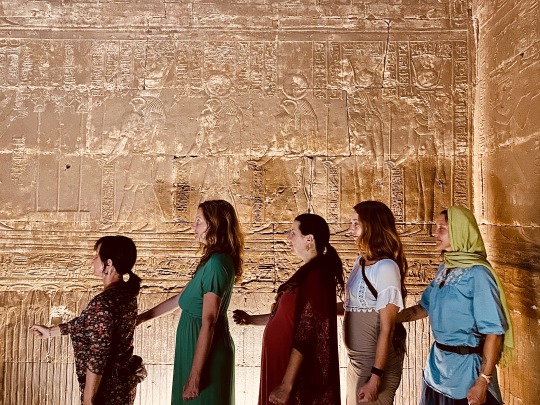

After an enchanting time at this temple we headed back on our horse chariots back to the ship and then cruised down through the night to Luxor!
Day 6- In the morning, We left the boat and embarked on an all day journey out into the desert to Dendara and Abydos- first to the Temple of Hathor and then to the Temple of Osiris- both absolutely stunning in beauty and energy.
Hathor is the Goddess of Beauty, Healing, Joy, Music, Femininity, Fertility and motherhood. She is the cow headed goddess and consort to Horus. This temple is considered one of the most beautiful temples, because of its detailed art that covers its walls and high columns. What was especially impressive was the prevalence zodiac art on the high ceilings. This was a place of healing also, and the tempe had its own large water reservoir next to it. There was a lot to see here, with many rooms and interesting and mysterious art depictions. Again we were blessed to experience this temple at a very quiet time, with not too many tourists. We had a beautiful ritual in a private back temple building, in which we were given the key to enter the locked door and we sat inside for an undisturbed time. I feel like we were in a building that was once for the temple priestesses to prepare for rituals in the main temple, almost like an ancient “green room.” As you will see, many of the faces of Hathor on the large pillars were etched out and destroyed, but I did find some intact ones in the excavated pieces that lie in front of the temple. (see photos) Also seen at this temple is the god Bes, ancient Egyptian god of childbirth, fertility, sexuality, humor, and war, but served primarily as a protector god of pregnant women and children. He is regularly depicted as a dwarf with large ears, long-haired and bearded, with prominent genitals, and bow-legged.

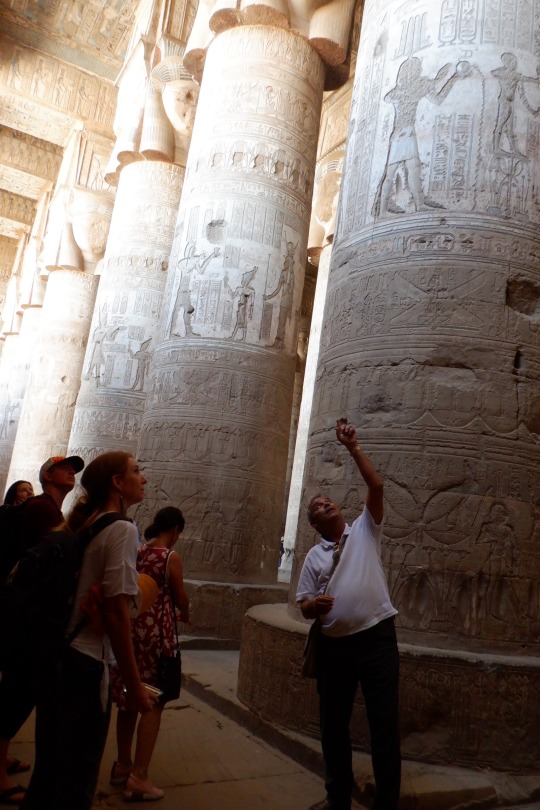
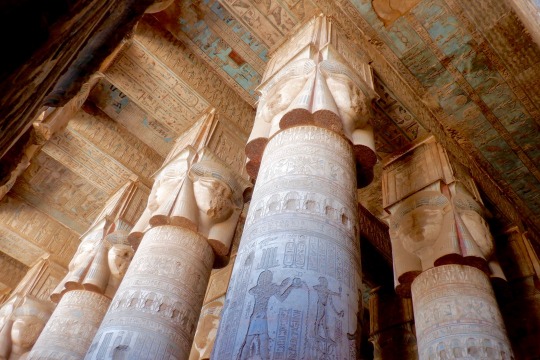



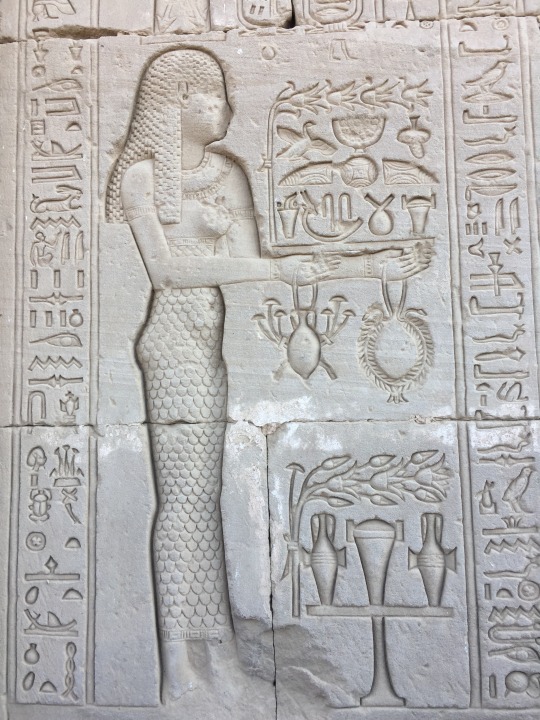


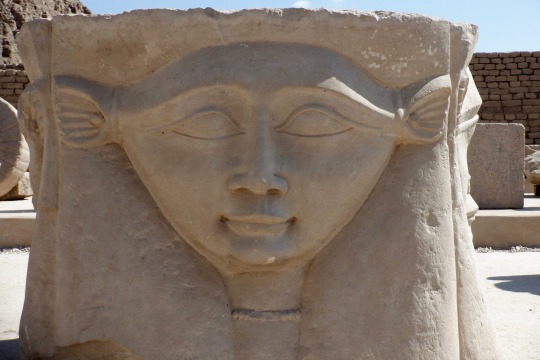

After our beautiful, enjoyable (and very hot) time in Dendara, we continued on our long drive to Abydos to the temple of Seti (temple of Osiris). This is a place of great interest, as the Temple of Seti is thought have been added on to more ancient Osireon which lies behind it. There are various reasons for this theory. The Osireon was built at a much lower level that the temple of Seti and is constructed with MASSIVE blocks of stone. The whole appearance of it is actually very similar to the valley temple that lies in front of the great Sphinx. There are little to no heiroglyphs on the structures, the only markings that can be found interestingly are two flower of life painted symbols- which are very faint and hard to see, especially since there was no access to go into the actual temple area itself, we could only stand out on the perimeters. Also there is water present at the base of this ancient temple, due to its closeness to the water table. It is thought that is temple was where the sacred rites of Osiris were practiced and that it was a place of healing and magic. Once again, our time at this site was blessed, we had it to ourselves! It was very quiet, in an almost eerie way. It was also very dark, and a very masculine energy, a stark contrast from Dendara. There were many bats prevalent here too. As you’ll see in the art, Osiris is depicted commonly a green color, since he is the God of the underworld as well as Resurrection. What color do you turn after you die? In the last photos you can see the Osireion, which is notably very different looking. Look how massive those blocks of stone are!
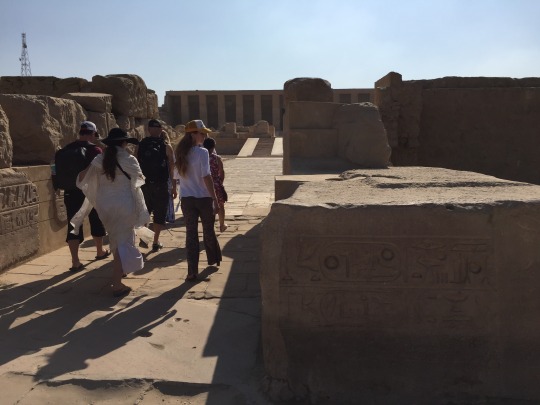




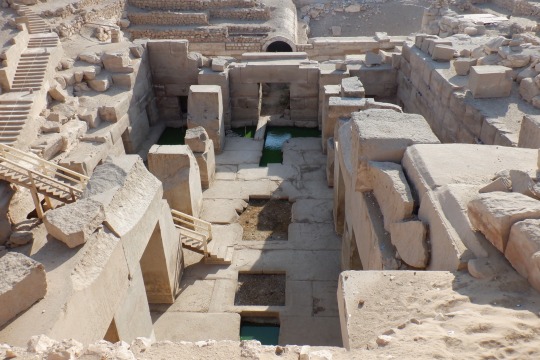
It was a long drive back to the Mayfair and I enjoyed the drive, watching all the scenery and waving at kids in cars and on the street. I also sang some songs, and led a little sing along in the bus.
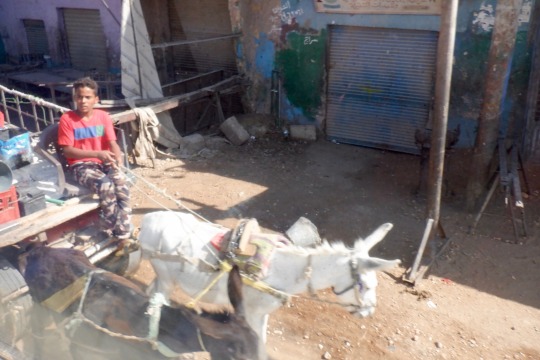
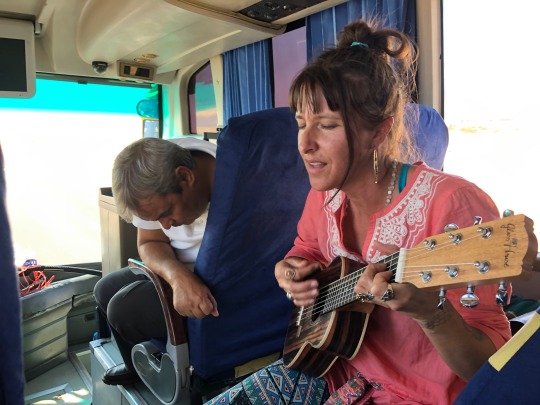
That our guide Yasser (above) listening intently. :)

Day 7- Valley of the Kings/Queens. We checked out of the Mayfair Cruise on this day and checked into the Sonesta St. George Hotel, in Luxor, which is situated on the Nile. It was a really nice hotel. After we were checked in we headed out on our big day to the Valley of the Kings and the Temple of Queen Hatchepsut. The Valley of the Kings is a vast necropolis located on the west side of the Nile in the stunning limestone and sedimentary rock high cliffed mountains. There are 60 known tombs in the Valley of the Kings. what is incredible to consider is that they were put there for the purpose of never being found and disturbed! The monumental amount of work and detail goes into the building of these tombs left me feeling speechless. They are all located deep in the earth, and are ornately decorated along their walls. Most of the tombs were raided early on, yet even with what is left is awe-inspiring. The one very famous tomb is of “King Tut,” which was the one that had been found more recently than the others, and was still intact- All of the incredible treasures are now Cairo’s museum, so we didn’t even bother to go to the actual tomb, since it was empty and apparently the walls are pretty bare. One of most impressive of the tombs we did go into was of Ramses the 4 and 6th.
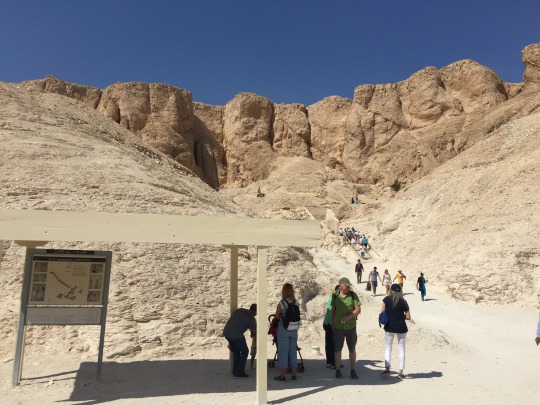

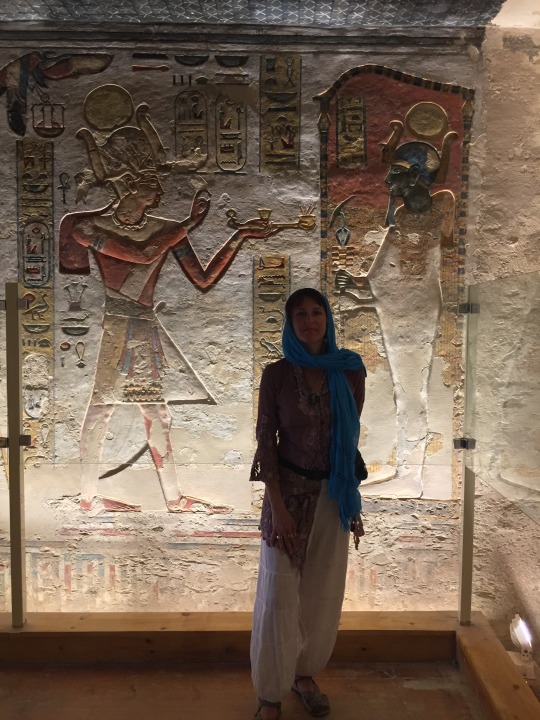


After exploring deep into about four of these massive tombs, we headed to Queen Hatchepsut’s temple and mortuary complex around in the next valley over. I am rather fascinated by this Queen, who was one two women who were pharoahs. She ruled possibly 20 years and was a well loved Queen who accomplished a lot for the benefit of her people. Although this is her mortuary temple, she was not buried here- she was buried in the Valley of the Kings. During the winter solstice, sunlight is able to penetrate the inside of the inner chapel, falling first on the chapel’s rear wall, and then moving across slowly to illuminate a large statue of Osiris. There is also an additional light box that allows a square of light to follow the temple’s central axis. As it travels along the axis, it first illuminates a statue of the god Amen-Ra, then a kneeling statue of King Thutmose III (her husband), and then finally a statue of Hapi the Nile god.I enjoyed this temple immensely, especially the portion dedicated to Hathor on the upper left side. Afterwards we went to the artisan village where people carve alabaster jars, statues and all sorts of things. Then we had a delicious Egyptian lunch overlooking the Nile river, with Luxor temple just on the other side. Then we went back to the nice hotel and chilled out, it was a beautiful sunset!





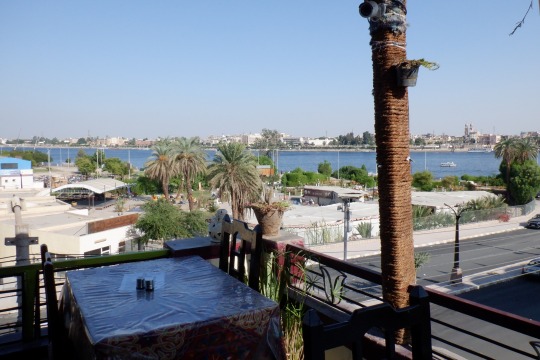
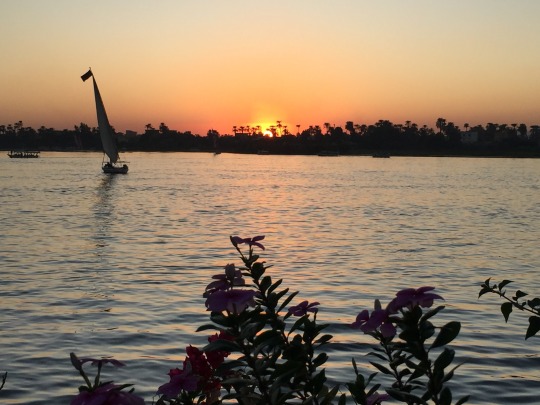
Day 8- Karnak and Luxor- Luxor is the arabic name meaning many palaces, and it used to be called Thebes by the Greek. It was at one time the most important political and religious center of Egypt. Luxor and Karnak temples are actually connected by a 1.7 mile avenue of Sphinxs, and there is a massive restoration project underway right now to clear this avenue to make it traversable again. Luxor was where the rise of the creator sun god Amun made the rise. Amun is depicted as a ram headed god. The worship of this almighty Amun which later became Amun-Ra, became a widespread yet it wasn’t until the rule of pharaoh Akhenaten that some major shifts started happening. He made some really big changes by banning polytheistic religion and instating a monotheistic religion of the worship of Aten. He had a new city built, Akhetaten, and abandoned Thebes as his capital. He also ordered the destruction of many polytheistic statue sites. When Akhenaten died in 1336 BCE, his son Tutankhaten (”King Tut”) took the throne, changed his name to Tutankhamun (1336-1327 BCE), and moved the capital of Egypt back to Thebes. He reinstated the old Egyptian religion and opened all the temples. Being so very young, he was likely advised by his councillors to bring back the old ways to bring back the balance, the ma’at, which was ancient Egypt’s most important principle.

Karnak is the largest religious temple complex in the world, covering 247 acres, its a massive site with lots to see, with its giant obelisks (made of one single piece of granite!), over 130 huge pillars. Two hours was not really enough. It was built as a site for the worship of Amun but there are other temple on the site as well to the ancient mother earth goddess Mut, and to falcon god Montu. Much of our time was at the small side temple to ancient creator, craftsman and healer god Ptah and his consort Sekhmet, the lion headed goddess of War, divine retribution and also healing. She is one of the most ancient and most fierce goddess that is called upon in times of war and in times of transformation Sekhmet was mentioned a number of times in the spells of The Book of the Dead as both a creative and destructive force, but above all, she is the protector of Maat (balance or justice) named “The One Who Loves Ma’at and Who Detests Evil.” We had a powerful group ritual, privately within this room with Sekhmet, (once again, we were given the key to the locked room) and we amazingly had around 30 minutes, completely undisturbed, with which our guide exclaimed afterwards, “that just doesn’t happen! You are very blessed!” I made a vow that day to let go of my tendency to fear and worry, and I layed it all down at the feet of Sekhmet. I could feel the burden of suffering that was lifted from that willingness to just let it go. Another area I enjoyed exploring is the far eastern portion of the temple, behind the sanctuary of Amun, known as the botanical gardens, which was built by Thutmoses III (husband of Queen Hatchepsut). It was an area open to the sky with low walls uniquely decorated with carvings of plants and animals.




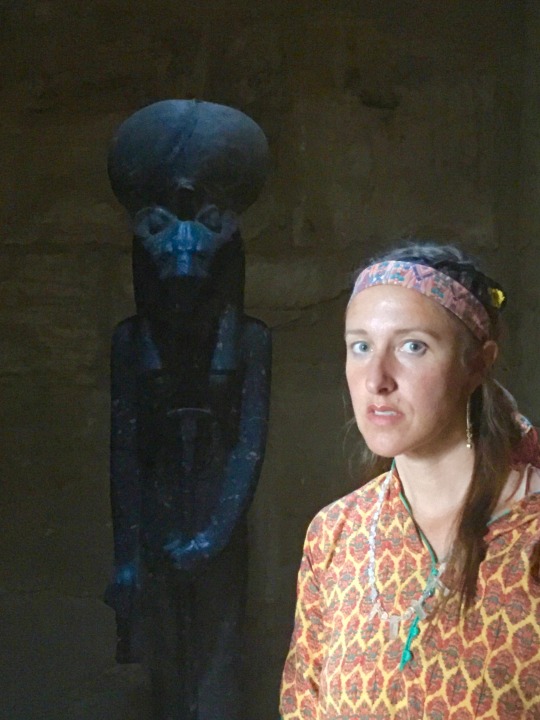

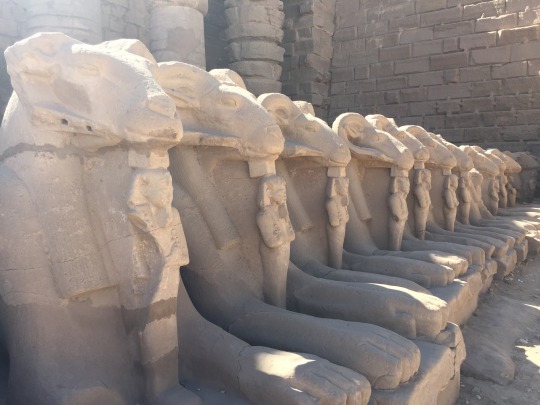
After visiting Karnak we went to a special Egyptian perfumery run by a man who has been working with the sacred essential oils since his youth. He was an intuitive fellow that could easily read peoples energy and suggest what oils would be most beneficial for them. We got an in depth talk from him about the oils and the ancient Egyptian roots of perfumery and then of course we all ended up purchasing some. Since I was the very last person to decide on which oil I wanted ( I wanted them all!!) I finally narrowed it down to Jasmine, which is supposed to be good for the solar plexus- but I was lucky enough to have gotten gifted a $50 bottle of the rose oil too (which of course I had really wanted!).


That evening, after a beautiful sunset, Tara and I marveled at the view from our hotel balcony of the new waxing moon low in the sky, with Venus, Mercury and Jupiter all visible! We went to the temple of Luxor to walk within its grandeur under the stars. This temple is also called “the temple of Man” as its massive layout, as seen from above, models the human body with its perfect geometry. Our last ritual was successfully carried out in the very back of the temple, which would be like the “crown chakra” of the body After the ritual was sealed we had time to wander and marvel at the massive palace like Luxor temple and soak up the energy of this living temple. An interesting detail inside this temple is a mosque that was built later, within the temple. I visited this mosque the next day and ushered in by an enthusiastic person and was shown the interior and how within the mosque walls are the giant pillars of Luxor temple with their ancient hieroglyphs. Inside the mosque are a couple old tombs of Sufi saints as well as rooms for worship.


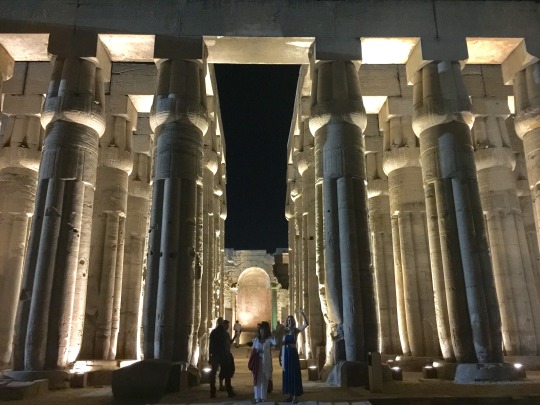



The following day we had a good amount to time to relax before heading back to the Aswan airport to fly back to Cairo. After arriving in Cairo we had a lengthy drive to get to the Four Seasons hotel, through crazy Cairo traffic. But we were stoked when we arrived! That was most definitely the nicest hotel I’ve ever stayed in! Wow. We had a fun group dinner together in the Lebanese restaurant there, it was delicious!! Oh how I LOVE middle eastern food! The following day (Halloween!) we went to the Egyptian museum of Cairo, which houses many amazing treasures: countless statues, old relics, ancient jewelry and most impressive : the contents of King Tutankhamen’s tomb. It was there that we could also look upon his golden throne and many of his personal objects and most prized: the amazing gold mask that had been on his mummy- made of solid gold and inlay of lapis lazuli, obsidian, and quartz. It is around 2 feet long and weighs 25 pounds. What I found most impressive were his number of actual sarcophagi, I think there were like 5 giant golden boxes, one which fit into another. Also what was amazing to see was the stone box that held King Tut’s canopic jars- the jars that held his vital organs for the afterlife!!! After asking my guide Yasser, “Why is it that this King’s tomb was so extravagant?” and he answered- “They all were most likely like this, its just that his tomb was the only one found intact, and was not yet robbed.” This made me wonder- what has happened to all those stolen tomb treasures- treasures that were never intended to be touched or taken by anyone.


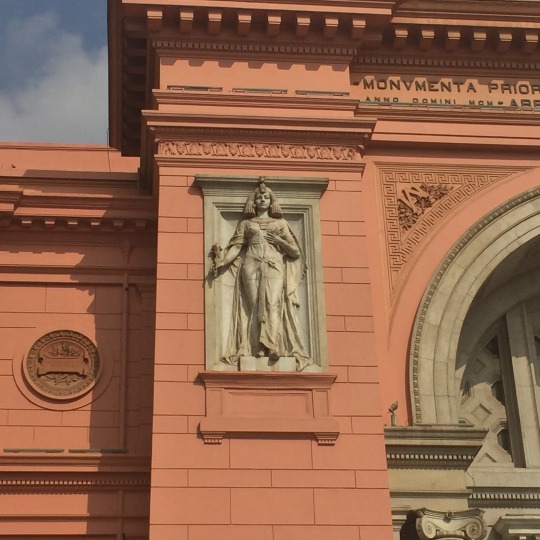


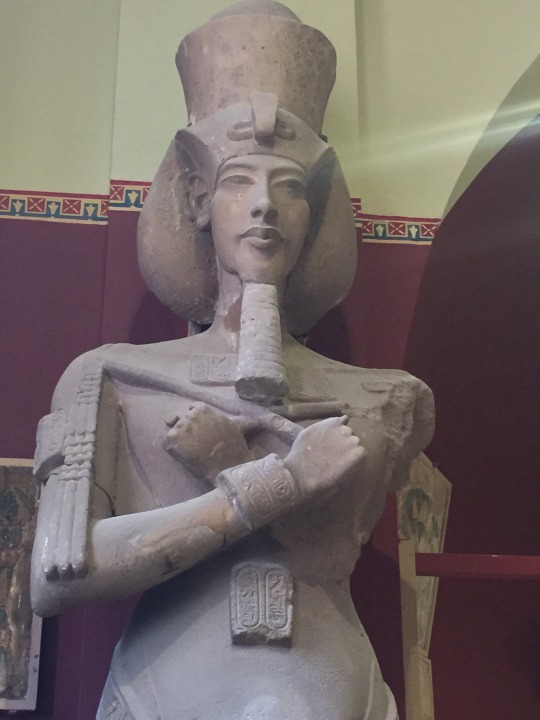


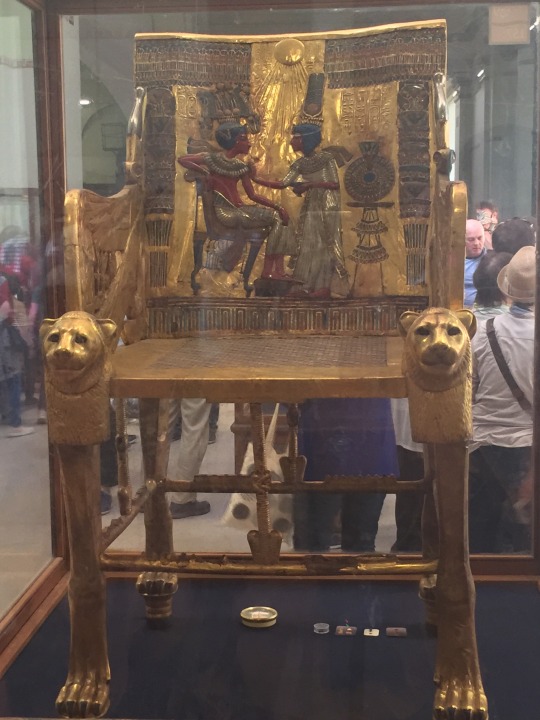


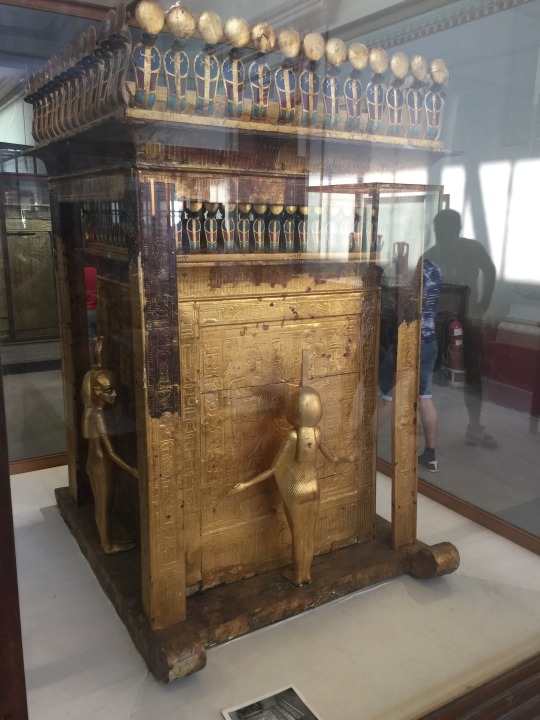
After the museum we went to the Grand Bazaar of Cairo and had some shopping time. I didn’t do too much of that since I didn’t really have money to spend by this point! It was sure fun to look though! I didn’t have too much energy to haggle over prices, and I realized that really does suck my energy. Also, many of the store owners call out at you, asking questions like “where are you from?” in hopes to capture your attention. But most of the time they are really just trying to get you to come into their stores. A common tradition of hospitality is also offering you tea when you are in their store. I drank my fair share of tea, let me tell you ( in Turkey too)!



After the shopping bonanza we went for our last lunch together at a lovely place that overlooked a big garden area. There were many people there enjoying the day, especially many young school children, maybe on outings with their classes? I was actually starting to feel a little sad, knowing this was the end of our trip, but feeling very grateful too!


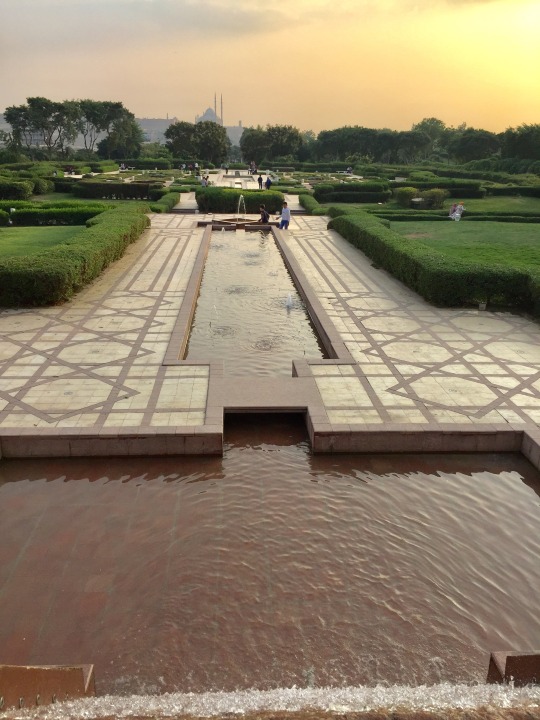
I departed early the next morning, back to the airport. I had three more nights in Germany, getting to visit with my dear old friend Aurora and her sweet family. What a contrast that was all of the sudden being in the clear cool air and magical forests! It was the perfect transition to returning home, where it was even colder! Well, its been a relaxing and reflective last few days integrating this big journey! Thanks for reading and following along! I am ever grateful for the support I received from loved ones to make this dream a reality! Would I go back? YES. If fact, I can recommend our amazing guide Yasser Al-Wahab, to anyone interested in making this sacred pilgrimage to Egypt, you would be in expert hands!
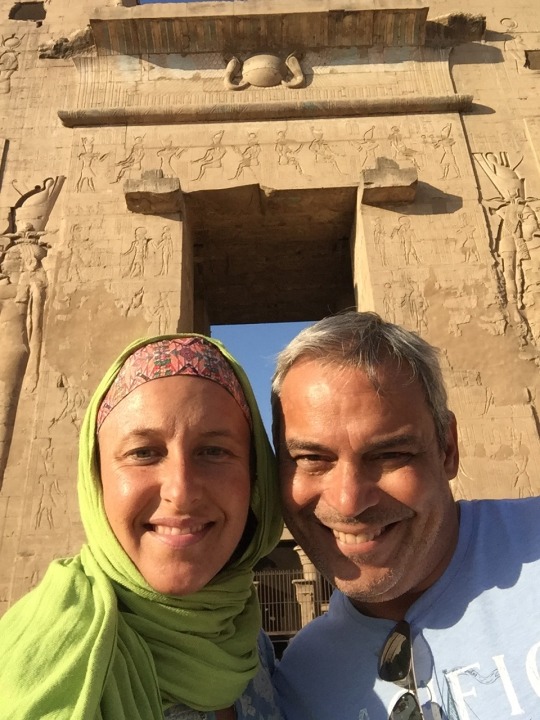
And here’s a few refreshing pics of Germany below!


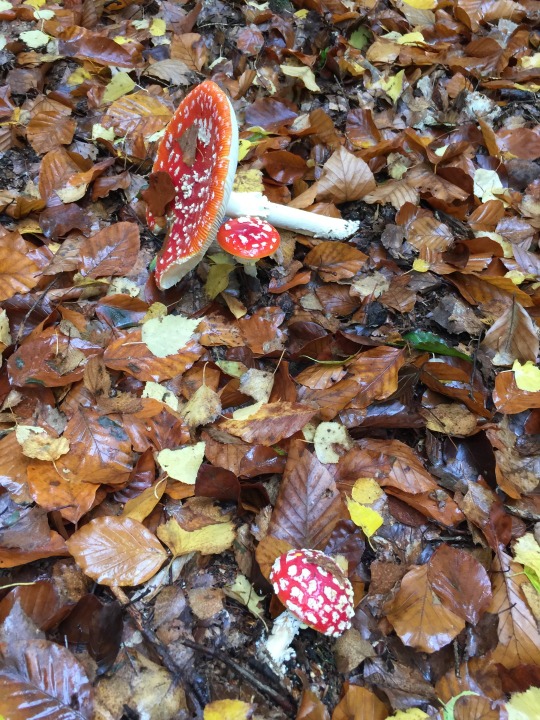
#turkey#smyrna#ephesus#efes#ancient monuments#ancient civilization#ancient places#aegean#traveling the world#travel blog#ancient egypt#ancient temples#karnak#aswan#cairo#gods of egypt#amazing egypt#egyptology#ancient egyptian#heiroglyphs#temple art#temples#luxor#egypt travel#egypt tour
0 notes
Text
Manifest

Philippines Tourism Manifest
They say that beauty is in the eye of the beholder, but when faced with immaculate beaches, virgin forests, and crisp, fresh air among 7,107 islands, how can anyone deny such unparalleled wonder? From the jam-packed shores of Boracay to the quieter, less-travelled, and less-paved roads of Batad, the Philippines has an undeniable charm that both foreigners and locals are in awe of. But without proper tourism efforts, how can hidden gems be more well-known, or natural beauty be preserved?
The Impact of Tourism in the Country
As an economic sector, tourism is considered one of the fastest growing, especially when it comes to developing countries. With its power to advance local economic development, industrialization, and alleviation of poverty, tourism is as effective as can be in boosting a country’s overall well-being. For instance, an influx of tourists can wildly influence the country’s economic growth in terms of attractive foreign exchange investment (real estate, IT, agriculture, and the like), welcoming more and more international businesses to establish their roots in the country. We’ve all experienced (and warmly welcomed) the introduction of various foreign leisure and entertainment businesses in the Philippines, from the European high-fashion brands to the Asian milk tea craze—and why not? Globalization is always a good thing, and the more open our country can be, the better.
Tourism stimulates the growth of the export industry as well. Dried mangoes, for example, have always been a Philippine staple, and foreigners far and wide flock to the country in droves just to get a taste of the fresh sweetness of the summer fruit. Even the smallest homemade handicraft can be exported for a premium price—not to mention that the factories where these handicrafts are made also become tourist attractions in themselves. It can be anything from a mainstream guitar factory in Cebu to a more intimate bagoong-making backyard business in Pangasinan. What was once a less-populated town can easily become the next big thing on an eager traveller’s itinerary, mainly because tourists thirst for meaningful experiences rather than manufactured tours. A simple yet genuine homemade product can make tourists travel to even the most remote locations if only to appreciate the wealth of culture that the site holds.
On a more localized scale, tourism can also greatly assist in uplifting the lives of the people in the rural areas for the better. Regional development not only influences the diversification of the local economy, but it also means more employment opportunities for local residents, leading to more income which allows even small Mom-and-Pop businesses to thrive. Imagine a humble seller of soy pudding (known locally as taho) who peddles his homemade wares in a food cart. If a tourist stumbles upon his recipe and enjoys it, there will be more demand for his taho, prompting him to increase his production to cater to more customers. Fellow locals can also begin to increase their own supply to meet outside demand, attracting more tourists to the area, and eventually leading to improved infrastructure, accommodation solutions, and better business opportunities. This kind of “snowball effect” also leads to better health services in the area, as more investors contribute to the development of a once-rural spot. In turn, domestic household consumption increases, the government provides more funding to develop roads in the area, and better commercial services become available, contributing to the improvement of a family’s quality of life.
Challenges That Need to be Overcome
Of course, all of these factors come with their own set of problems that need to be solved. There are undoubtedly a myriad of challenges to be faced and hurdles that need to be addressed if we are to foster and endorse better tourism in the country.
To start, not all local tourist spots receive proper support from the government, and sometimes even from fellow residents. Often, the lesser-known tourist spots are plagued with bad infrastructure, insufficient funding, poor communications, lack of electricity and water supply, inaccessible sources of fresh food, and lack of awareness from the public. To cite an example, ordering a warm, freshly cooked meal in a cafeteria in the mountains of Batad can take approximately two hours, so the order must be made in advance. In other sites, families are often steeped in poverty, and because these hidden gems aren’t as widely advertised as the other more mainstream tourist spots in the country, they are seldom visited by foreigners. Moreover, if by the slim chance that a wayward traveller does stumble upon the location, the spot is so inaccessible and so hard to reach that people usually no longer return, much less promote the area to their family and friends even by word of mouth.
A perfect example is the Quitinday Green Hills Formation Reserve in Albay. Bicol is more commonly known for the majestic and perfect cone of Mount Mayon, but what not a lot of casual tourists know is that there is a different hill formation that also deserves attention. Known as the “Chocolate Hills of Albay”, the Quitinday Green Hills also boast of adorable, round-topped hills with lush foliage that can be seen across a wide expanse of green. The problem here is that to get to the top of the hills, one would need to travel up an underdeveloped mountainside with a severe lack of signs that direct you to your destination. Roads are narrow, confusing, and can be quite terrifying for the lone first-timer, and when you finally reach the landing by car, you are simply met with a makeshift booth with unprofessionally clad (albeit very friendly) attendants. The climb by foot to the very top is also quite unsafe, as there are no metal handrails (only makeshift bamboos) to support you should you slip and fall. Of course, the breathtaking view at the very top is definitely a marvel, and an experience that’s one for the books—it’s just too bad that there is a lack of funding and promotion for the spot itself.
Solutions Toward More Sustainable Tourism
The goal here, of course, is to present solutions that we can all strive for in order to achieve a more sustainable tourism in the country. If we are to maintain world-class tourist destinations to drive more overall development for the country and its people, then we should take drastic steps to protect the Philippines’ best-kept tourist spots, natural assets, and cultural gems.
A big step would be for both the local government and the residents to formulate an integrated strategy for comprehensive tourism development, including marketing, funding, training, public awareness, and local participation. The positive role of tourism in an area should be made known to all, so that each and every citizen will work with each other to promote tourism and local businesses, which, in turn, will lead to better development of roads and infrastructure in the area. Coordinated efforts need to be made to create events and various partnerships with organizations to attract foreign visitors.
Damage to the environment and the irreversibility of our carbon footprint can be seen perfectly in Boracay, the pristine shores of which became so polluted that the government had to forcibly shut the area down for half a year for rehabilitation. Manila Bay, a famous landmark located in the heart of the capital, is now currently undergoing rehabilitation as well, with both private and public sectors tirelessly working together for the clean-up in hopes of solving the Bay’s long-festering problems. To keep this from happening and to prevent overcrowding, better awareness programs must be put in place to advertise the lesser-known tourists spots. This is to successfully divert the vacationers and crowds elsewhere and to help them uncover the undiscovered gems. For instance, the rainforest-covered Danjugan Island in Cauayan, Negros Occidental is not only a marine sanctuary, but is also a protected area where fishing is not allowed. Only a limited number of guests are accepted daily, ensuring the island’s survival for a long, long time.
Most importantly, everyone should do his or her part in environmental protection (e.g. strict implementation of the required coastal setback, international standards, and the protection of endangered species), so that natural resources will be preserved for sustainability in the long run.
How can I help?
What, then, does this mean for us Filipinos? What do we need to do, and how can we contribute our part to develop tourism in the Philippines?
Tourism highlights the uniqueness of our culture, as well as encourages the expansion of small-scale enterprises and local infrastructure. It opens up lines of communication across plenty of networks, and provides revenue to residents and the local baranggay alike. This kind of holistic development also positively affects public safety in the area, access to medical assistance, quality of education, and so much more.
In line with this, isn’t it only natural for us to promote the natural resources of our country? Should we not exert every effort to support our local industries, share our talents to other parts of the region and to other countries, and tell our own stories to the world?
There is a rich diversity of beautiful tourist spots that have yet to be explored, and if we only gather the courage to find our voices, then we can drive more people to come visit. After all, there is great joy in taking the road less travelled, and with local tourism, sharing our stories to the world is the best way to take pride in our Filipino identity.
Read the full article
0 notes
Video
youtube
Slowly Savannah and I are clocking away thousands of kilometers in South Africa. After 7 weeks, we have reached our 5.000km milestone. During my Asian and South American adventures, I would ride about 5000km each month, but a Honda CRF250L is not made to churn out 700 kilometers a day. That is okay, because here in South Africa I am riding a lot more on dirt roads than I have ever done before during my motorcycle travels. It makes me a very happy adventure rider!
South Africa adventure motorcycle galore
As soon as I arrived in Johannesburg, it dawned on me that South Africa does not only have a huge motorcycle scene, it also has a huge motorcycle adventure scene! With hundreds of mountain passes, dirt roads going through deserts, lush green landscapes, and miles of coastal roads, there is an adventure ride around every corner.
As in many other countries, the BMW GS is the most sold bike here. In my opinion, you don’t necessarily need a big (and expensive) BMW GS to experience the best of South Africa. On the other hand, South Africa is a big country. So I understand why people would like to have a powerful bike to ride with. It makes commuting to another part of the country a lot more comfortable.
Recently, I met three locals riding their BMW GS. They told me that they had ridden 800 kilometers on their first day when leaving Johannesburg, averaging 160 kilometers per hour on the highway. Such a trip would take Savannah and me two long and exhausting days! Luckily, I don’t want to cover 800 kilometers in one day. I prefer to ride on dirt roads, take it slow, and enjoy all the amazing dirt roads and sceneries.
Blending in with locals
The second thing that completely took me by surprise was how easy it was for me to blend in with the locals. With my blond hair, blue eyes, and an obvious Dutch accent, I thought they would know I was a foreigner. But many didn’t. Maybe because of my South African license plates. Or maybe because Dutch and Afrikaans are quite similar languages, which makes it more difficult to hear the difference when speaking English. Maybe that is why people think I am a South African too.
All in all, traveling here is quite different from traveling in South America or Asia where I was never seen as a local. Also within Europe, people always knew I was from abroad due to my Dutch or Indian license plates. When you are abroad, and everybody thinks you are local, you begin to feel like a local too. And that has certainly given a different feeling to my adventure in South Africa. I feel at home here, even though I have no idea what’s around the next corner!
South African friendliness
Let’s face it, the crime rates in South Africa are pretty bad. I expected to be met with reservation as I am a stranger after all. In addition to that, I knew that South Africa has a complicated history with lots of conflicts. In these past two months, I’ve spoken to many Afrikaners, English-speaking people, Xhosa people, Zulu people, and many, many other South Africans. They all met me with smiles and often wanted to take a picture with me.
I was surprised by their openness and willingness to share a part of their lives with me. On the other hand, the one thing I learned from traveling all over the world is that 99% of people are good people. The South Africans are no exception to that.
Diverse local cuisine
Another surprise for me was the South African cuisine. Besides the type of roads and the people I meet during my motorcycle adventures, one other important aspect of ranking a country high on my favorite list is the food that is being served. Thanks to the melting pot of people living in South Africa, a unique South African flavor has been created. You find here many different cuisines originating from all over the world. One of my highlights regarding food was the bunny chow, a curry served inside a hollowed-out bread. It is an absolute calorie bomb dish from Durban and very spicy. I loved it! And as I am approaching Cape Town, I look forward to sampling more of those typical Cape Malay dishes like bobotie and Cape Malay yellow riceC.
Besides having a huge variety of local dishes, I also noticed that South Africans love sweets and desserts. I’ve tried several of them already. One of them being koeksisters. It tasted like pure sugar, so it was a bit too sweet for my taste. I absolutely loved the milk tart though. It looks a bit like cheesecake but is much milkier, hence the name, and it has a nice crusty crust. Honestly, I could eat this tart every day. Another dessert I tried was malva pudding. It is a sort of sponge cake with apricot jam and often a hot creamy sauce is poured over it. Even though I am not a big pudding fan, this one was exceptional!
And then there are the braaibroodjes, roosterkoek, rusks, vetkoek and many more mouth watering foods I got to try in the past weeks!
Not able to see and experience everything
The weeks are ticking away on my South African visa. I probably could keep riding in South Africa for another year and still not have covered every amazing dirt road there is. Nor would I have met with all the different people living here, or sample all the delicious dishes of the South African cuisine. On the other hand, I am also looking forward to explore the next country on the African continent. And isn’t it better to leave a country knowing you have not seen everything, so you can go back and get surprised again?
1 note
·
View note
Text
CRAZY Drone #Lightshow in Long Beach!! - #Coastalcountry

Our exclusive footage captures the awe-inspiring aerial display that lit up the night sky. #DroneLightShow #CoastalCountryJam #LongBeachSpectacle #AerialDisplay #CRAZYDroneShow #NightSkySpectacular #CoastalCountryJamExperience #DroneMagic #ElectrifyingMoments #SpectacleUnveiled
View: https://youtube.com/shorts/-pHLaT_uZDg
#CRAZY Drone Light Show#Coastal Country Jam Spectacle#Long Beach Aerial Display#Long Beach Event Highlights#Spectacular Drone Performance#CRAZY Light Show Video#Coastal Country Jam Night Sky#Drone Magic Over Coastal Country Jam#Long Beach Spectacle Moments#CRAZY Drone Show Finale#Electrifying Night Sky Event#Long Beach Drone Spectacle#long beach#drone#long beach california#light show#best drone#country music#live music#nashville#air show
0 notes
Quote
Wonho Frank Lee
Sqirl, the LA darling known for its ricotta toast with jam, is under fire for allegedly selling moldy jam and harboring a secret kitchen
Last year, the New York Times asked of LA’s Sqirl and its founder, Jessica Koslow, “Can you build an empire out of jam?” Sqirl is synonymous with a certain cool, aspirational, and white version of LA. It is the epicenter of “clean” comfort food, serving grain bowls with eggs and sorrel, avocado toast, turmeric drinks, and its iconic ricotta jam toast, which Eater’s Meghan McCarron described as like “eating a gigantic slice of cake, but a nourishing one, like a sweet and hearty childhood breakfast.”
Much of that enjoyment hinges on Koslow’s reputation as an expert jam maker. But over the weekend, allegations circulated painting a picture of a dirty, unhealthy kitchen filled with buckets of Sqirl’s signature product covered in mold.
The allegations have been compiled by Joe Rosenthal on Instagram, and many come from people who appear to be former Sqirl employees. Like many restaurants in recent weeks, the callout seems to have started after Sqirl posted about donating profits to anti-racism causes. Comments began piling regarding Sqirl’s hand in gentrifying its neighborhood, and the lack of diversity among Sqirl’s staff. Then, people who appeared to have worked at Sqirl accused the restaurant and growing jam giant of regularly serving jam that had grown mold. “We’re talking about some buckets having like 1⁄4 inch of mold covering the entire tops of gallon buckets,” one of the posts alleged. The former employees allege Koslow herself instructed them to just scrape the mold off before serving.
An employee from sqirl shared this photo of the moldy jam from their kitchen. The fact that were told to just scrape the mold off is pic.twitter.com/uPCsevWoBi
— h (@hanaymoi) July 12, 2020
Aside from the confusion as to why jam, aka preserves, would develop mold so quickly, former employees also allege Koslow deliberately hid the moldy jam from health inspectors. At least one person alleges that it was because there was mold on a fan in the storage room, which would blow spores over the open buckets. But also, employees say they were repeatedly told it was okay to serve. “We were told that the health department gave us permission to scoop the mold off if it went two inches down,” said one former employee. Others say they were asked to hide the jam until inspectors were gone. Which all seems like a lot more work than making jam that doesn’t mold in the first place.
Joe Rosenthal
Joe Rosenthal
Sqirl has responded to the allegations on Instagram, saying that because it doesn’t use commercial pectin, stabilizers, or much sugar, “a low sugar jam is more susceptible to the growth of mold.” It also claims it did serve jam that had been in moldy batches, but that was done “with the guidance of preservation mentors and experts like Dr. Patrick Hickey,” a mycologist who previously told the BBC that it is perfectly safe to eat moldy jam if you scrape it off.
Sqirl
The morbid glee over the Sqirl takedown is familiar to anyone who enjoyed watching that perfect, untouchable girl in high school finally revealed to have a flaw: There is plenty of boasting on the internet over never having liked Sqirl in the first place, of thinking its proprietors were pretentious, fussy gentrifiers before hating them was cool. But what makes the story so viral (or spore-ful) is watching a place that has built its brand not just on jam, but on the goodness of “real” food get taken down for precisely what it supposedly does best. So far, no one has claimed to have gotten sick off Sqirl’s jam, but it’s shocking and disgusting and allows for everyone who never posted an artfully lit photo of the jam toast or the line down the block to feel incredibly smug.
Hey look! I fried an egg and put some avocado on toast — and I didn’t have to pay $20 to Sqirl and contribute to gentrification to do so. pic.twitter.com/GVwFCMs6wT
— Kat Bee (@katbeee) July 13, 2020
the sqirl thing is great because anyone paying $2 extra for syrup on a single $14 piece of toast deserves to die of rat shit and mold poisoning pic.twitter.com/FIkPNi1WUa
— Germaphobe Sean (@GermaphobeSean) July 13, 2020
i hate how heavily twitter weighs content from LA, why do i now hate a restaurant called Sqirl for selling moldy jam? i am in nashville, tn, we make our own jam here, who are you people
— Marc G (@mac_gere) July 12, 2020
Haha I’ve been to Sqirl with so many people saying they always hated it now... it’s cool you can admit you once liked and paid for something that ended up being flawed!
— Emily Yoshida (@emilyyoshida) July 13, 2020
While the jam is certainly the visual shocker, many of the other allegations against Sqirl and Koslow are about presenting an aura of progressiveness while treating employees of color unfairly. Javier Ramos, former chef de cuisine at Sqirl, posted to his Instagram stories a screenshot of a comment he left on a different Instagram account, claiming Koslow “took credit” for his work, and that he “didn’t get recognition or payment for the recipes that I contributed to the cookbook.” Ria Dolly Barbosa also commented that Koslow “took credit for the first two years I was her chef there,” and said the jam toast itself was the invention of chef Matt Wilson, not Koslow. (Neither Koslow nor Sqirl has commented on these allegations.)
Ria Dolly Barbasoa
Aside from the internet backlash, Sqirl appears to have suffered one tangible consequence of this expose. Diaspora Co, a sustainable spice country known for its single-origin turmeric, released a statement on its recent jam collaboration with Sqirl. “After hours of conversations with Sqirl employees (current and former), a mold expose, and some difficult convos with Sqirl leadership, we are here to say this collab was a mistake.” The company had hoped it could highlight BIPOC (Black, indigenous, and people of color) farmers, but decided “the collab gave Sqirl another trendy marketing boost.” The company has pulled the remaining jars from its site, and is offering refunds.
It’s quite possible the mold backlash will continue to dominate the food discourse for a while: For the majority of people who have not been to Sqirl, it’s pretty hilarious that the “coastal elites” have been caught fawning over moldy jam — but the problems may also go deeper than improper jam-cooling techniques. The restaurant has yet to acknowledge any allegations of mistreatment by former chefs.
from Eater - All https://ift.tt/3fqUaTM
http://easyfoodnetwork.blogspot.com/2020/07/why-internet-is-blowing-up-about-las.html
0 notes
Text
Truck drivers blamed for spread of COVID-19 in East Africa
Register at https://mignation.com The Only Social Network for Migrants. #Immigration, #Migration, #Mignation ---
New Post has been published on http://khalilhumam.com/truck-drivers-blamed-for-spread-of-covid-19-in-east-africa/
Truck drivers blamed for spread of COVID-19 in East Africa
Truck drivers are the heartbeat of regional trade
Truck with Kilimanjaro beers parked in Karatu town in Tanzania. Photo: Pernille Bærendtsen, used with permission.
The number of coronavirus cases remains relatively low in East Africa, but health officials note that border crossings— through which truck drivers pass daily with essential goods — have become hot spots for coronavirus contagion. While most of East Africa has been under varying degrees of lockdown, truck drivers are the heartbeat of regional trade who trek frequented routes in the region as essential workers. Borders between East African countries including Tanzania, Rwanda, Uganda, and Kenya have become sites of confusion, chaos, traffic queues and protests as truck drivers face an onslaught of new, temporary COVID-19 restrictions.
Kenya: Mandatory testing
Kenya has implemented mandatory COVID-19 testing at the Namanga border with Tanzania, causing massive delays and leaving drivers stranded with perishable goods.
TESTING THE TRUCKERS
Testing of truck drivers arriving from Tanzania enters day two
Drivers urge officials to reduce time it takes for test #CitizenWeekend pic.twitter.com/b0NIfg1Yx9 — Citizen TV Kenya (@citizentvkenya) May 10, 2020
As of May 14, least 33 truck drivers have tested positive at the border between Tanzania and Kenya in the town of Namanga.
#Kenya dispatches an emergency medical team to #Tanzania border to undertake mandatory testing for truckers at the #Namanga crossing as concerns mount over #Covid19 transmissions from the neighbouring country. pic.twitter.com/kMftcxIXrf — Dommy Ameti (@dommyametiKE) May 13, 2020
Kenyan truck drivers who tested positive were allowed to enter Kenya and self-isolate but Tanzanian drivers were denied entry and were forced to return home. It is unclear whether they were taken to health facilities to self-quarantine for 14 days or were expected to self-isolate at home.
Signpost for The First & Last Hotel in Namanga, on the Tanzanian side of the border with Kenya. Border transit towns in East Africa are often busy communities, which apart from immigration and customs, also provide other services such as bars, restaurants and lodges. Photo: Pernille Bærendtsen, used with permission.
Kenya's health minister Mercy Mwangangi said that aside from porous borders, “truck drivers are becoming the other weak link in the fight against the virus,” as reported in The Citizen, a Tanzanian daily. Truckers from Kenya must now present a certificate to prove that they are coronavirus-free before leaving or entering Kenya at entry points. Kenyan officials are considering closing the border with Tanzania to curb the spread of the virus, but no decisions have been made at this time.
Rwanda: Delays and protests
In early May, Tanzanian truckers were not happy when they arrived at Rwanda's Rusumo border with essential goods and were told to hand over their trucks to new drivers upon arrival. This “relay” measure was put in place by Rwandan authorities who saw an increase in virus cases among truck drivers. The directive led to reported bursts of violence at the Rusomo border, which was later debated on Twitter:
If this is true, then #Rwandan truck drivers in #Tanzania are not safe. @PSF_Rwanda @RwandaTrade #covid19Tanzania https://t.co/b8Iv684axQ — Richard Kwizera (@Muzungu4) May 5, 2020
This Twitter user called out the tension as xenophobia:
Somebody save our drivers from this xenophobia — Frank Kigenza (@Rwakigenza) May 5, 2020
Over 90 percent of Rwanda's goods are imported through Tanzania's cultural capital of Dar es Salaam via the Rusomo border, and this is where many of Rwanda's coronavirus cases have been reported, with the highest number recorded in a day. Most drivers do not ride with any form of personal protective equipment like face masks or gloves, noted Abdul Ndarubogoye, chairman of the Rwanda Truckers Association.
Uganda: Hunger, theft, traffic jams
For landlocked countries like Uganda and South Sudan, truck drivers are critical lifelines for transporting essential goods inland from coastal port cities like Dar es Salaam, Tanzania, and Mombasa, Kenya. Uganda was one of the first countries to enforce strict testing protocols at its borders — drivers must register at mandatory stops for testing and vehicle disinfectant. John Wanjiku, a driver from Kenya, said that he faced up to 11 screenings in a single trip from Nairobi to the Ugandan border, facing an 18-mile traffic jam. Drivers reported fears of running out of food and theft at night. Speak FM, in Gulu, northern Uganda, a transit town for trucks going to South Sudan, has repeatedly reported on the situation of truck drivers. On May 9, it reported 13 positive virus cases from a mass screening of 2,421 truck driver samples tested at border points, while samples from the community tested negative.
On May 14, 21 new COVID-19 cases were confirmed from 1,593 samples of truck drivers in Uganda, bringing the total number of virus cases in the country to 160.
Zambia: Border closures
Zambian President Edgar Lungu directed the Zambia-Tanzania border to close temporarily starting on May 11, while the border town of Nakonde was locked down. After testing over 900 people between May 13-14, Zambia's Ministry of Health reported a total of 654 cases as of May 15. Out of these, 398 cases were people residing in Nakonde, working in immigration, customs as well as truckers and sex workers. Both Tanzania and Zambia are part of the Southern African Development Community (SADEC), and the border crossing is central for Zambia's export of copper and cobalt, and fuel imports. On May 15, the border was reopened for cargo — not people — and the lockdown was lifted but is expected to be enforced again with further testing.
EAC ‘asleep’ at the wheel?
Amid the COVID-19 pandemic, truck drivers have faced an onslaught of stigma in East Africa. Media and government authorities have referred to them as “vectors,” “superspreaders” and “the weakest link” in the fight against the spread of the coronavirus. Sex workers, closely linked to truck drivers through communities typically formed around border transit towns in East Africa, have also attracted media attention as health authorities target, test and track them along truck driver routes. In an unusual move, Uganda's Ministry of Health collaborated with Ugandan socialite and self-proclaimed sex worker Bad Black, who in a video message addressed sex workers to stay away from truck drivers. Many netizens have questioned whether or not governments are doing enough to help protect truck drivers and border communities as a whole. On May 12, EAC leaders agreed to joint interventions to tackle COVID-19 and acknowledged the need to improve conditions for truck drivers. But Evelyn Lirri tweeted her doubts about the EAC and expressed concerns for the drivers:
Since the #EAC is asleep, or may be closed shop many moons ago, what are the companies that hire these #truck drivers doing to minimise the drivers’ risk of being infected with #COVID19? Or have they been left to the elements? https://t.co/gTtXfGqa15 — Evelyn Lirri (@Elirri) May 15, 2020
Rosebell Kagumire agreed, raising questions about occupational health and safety for truck drivers:
Great question! What does occupational health and safety look like for truck drivers among whom the highest cases of #covid19 are happening in East Africa? We tend to see them as vectors these days with every update saying truck drivers truck drivers truck drivers https://t.co/oSO8ljBdkD — Rosebell Kagumire (@RosebellK) May 15, 2020
These recent border tensions highlight larger policy issues within the East African Community (EAC) in terms of regional integration and sustainable, intraregional trade. The implementation of the African Continental Free Trade Area (AfCFTA) in East Africa “could result in welfare gains amounting to USD 1.8 billion for East Africa, boosting intra-African exports by more than USD 1.1 billion and creating more than 2 million new jobs,” says a new report.
Written by Amanda Lichtenstein, Pernille Baerendtsen · comments (0)
Donate · Share this: twitter facebook reddit
0 notes
Text
I Hate AirPods
I hate AirPods. No, actually, I loathe them, with a rabid, visceral, illogical fervor. Imagine my despair, then, in observing the way AirPods have proliferated, seemingly overnight, in the expensive coastal city in which I reside, sitting snugly like bleached pupae in the ears of everyone from finance bros to bus drivers. (Even some of my coworkers, whom I generally like and respect, wear them!)
It’s bad enough that AirPods are aesthetically hideous, turning their wearers into unwitting extras in some low-budget dystopian movie, and that they transform everyday public interactions into a dadaist act, wherein service workers and colleagues alike have to figure out if said AirPods-wearer is talking to you or some person literally in their head. (As one service worker recently told BuzzFeed News regarding AirPods use: “I think there’s a good percentage of people who don’t see me as a full person.”) But worst of all, AirPods have become, at least to me, the ultimate symbol of 21st-century conspicuous consumption. They represent the growing global sameness of the upper classes; you’ll find wearers among people of means in every country. That they are expensive, but not backbreakingly so, only makes them more appealing. (To other people, to be clear. Not to me.)
They are also harbingers of gentrification. When I read this story of new residents in Washington, DC’s Shaw neighborhood walking their dogs across Howard University’s historic Yard, I imagined they were wearing AirPods as they did it, because they just had to be. In this recent New York Times story about gentrification in Raleigh, North Carolina, a local pastor tries to get newer white residents to consider using the gym built by his church, but “the joggers tend to have earphones in and to look away.”
In the 2015 book The Edge Becomes the Center: An Oral History of Gentrification, author D.W. Gibson chats with one native of Brooklyn’s Bed-Stuy neighborhood, who talks about what the latest wave of gentrification feels like:
“[T]hey come here like we have a little more money, we’re driving rents up, we’re not going to be involved, we’re going to walk down the street with our headphones … I’ve started going on this campaign where if I’m walking and I notice that you have your headphones on, I’ll step in front of you and say, ‘Look up!’”
For that woman, headphones represent the transient nature of so many of these folks moving into these cities (people like me — though as I love to tell everyone, I’m trying to live in New York forever). Put your headphones on, and it’s easier to pretend you didn’t hear that person in front of the subway station asking you for money. (It’s also much easier to drown out street harassers, admittedly, but we shouldn’t have to rely on headphones as a solution for a larger societal problem.)
AirPods, with their conspicuous wirelessness and direct connection to Big Tech, are the symbolic culmination of that displacement. That they are small enough to rest in the ears of their wearers all day, easily undetectable, only highlights their insidiousness. AirPods are akin to cashless restaurants in that both innovations seem indicative of innocuous forward momentum, but actually gesture toward a future in which class barriers are represented in extremely visible ways. AirPods say, “I can afford not to hear the same sounds you do.”
This is where I implicate myself. I love (wired) earbuds; I’m wearing them right now as I type this essay in a noisy open-plan office. I used to sleep with earbuds beaming Tmsoft’s Box Fan Sound straight into my earholes on nights when my downstairs neighbor decided to update his playlist at 3 in the morning. I like to walk down the street with them in, listening to Coupé-Décalé and choreographing elaborate dance routines that I can never hope to actually execute.
But lately, as I’ve noticed the changing dynamics of the neighborhood I live in — the influx of Uniqlo-clad twenty- and thirtysomethings, clutching New Yorker tote bags, AirPods jammed in their ears, walking hurriedly past the mom trying to haul a stroller up the subway steps by herself — I’ve started to feel guilty about my own prolific earphone use. There’s something about being present. As I’m sure someone said one time, we hate the things that remind us most of our own shortcomings.
And so in many ways, my hatred of AirPods is actually just misdirected anger toward myself at being complicit in the rapid displacement of the working class in the city I live in, even as I try to persuade myself that as a black woman, I am somehow different — not as obtuse, not as likely to call the police on imaginary infractions. But wearing wired earbuds as opposed to AirPods is mainly a pointless, arbitrary display of superiority. There are so many ways in which we try to convince ourselves that our tastes Mean Something. That railing about gentrification can somehow bypass doing the hard work of trying to stop it, or just trying to engage in a meaningful way with the places where we live. At least my headphones are cheap, I reason. At least they don’t represent the growing, crippling hegemony of Big Tech.
When my phone from the Big Fruit Tech Company finally petered out about a year ago, a friendly Sprint employee persuaded me to upgrade to a newer model that doesn’t have a headphone jack. I didn’t realize this fact until it was too late. I almost screamed, until I realized there was a connector dongle included so I could continue to tote around my nondescript $30 headphones.
Lately, though, I’ve taken to wearing my earbuds around my neck like a chain, rather than in my ears — they’re easily accessible just in case, while permitting me to listen to other people’s conversations or even (scarily) to my own thoughts. I’m trying to be more present, more friendly, more aware of the world around me. It’s a slow-going process, and I’m not always in the mood to be fully in the world. But I’m trying. ●
Sahred From Source link Technology
from WordPress http://bit.ly/2VmP59m
via IFTTT
0 notes
Text
November
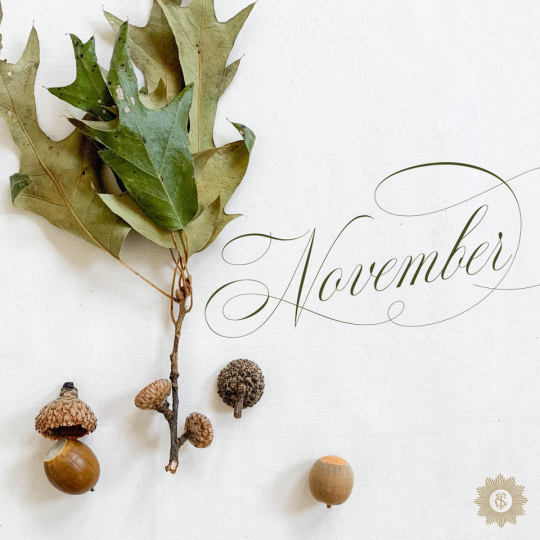
Between fall festivities and the busy holiday season closing in, there are a variety of exciting events happening in our communities in the coming weeks, providing countless opportunities to discover something new. From the launch of Mobile Ballet’s new season to celebrating new owners at Atchison Home to anticipating the upcoming holidays with the annual tree lighting in Fairhope, here’s what we’re looking forward to this month.
SALES
Haley Dermatology November Specials
Botox & Bingo Event November 15th $50 off 25+ Units and chances to win more!
15% off all SkinMedica Skincare
20% off Chemical Peels
Chin Special - buy 2 Coolsculpting mini cycles for the chin and receive a free kybella treatment! ($1200 Savings)
Ivy Cottage 20th Anniversary Sale
20% any item on November 8th
20% off all bed linens November 8th-14th
EVENTS
GREATER GULF STATE FAIR
October 26th- November 4th | The Grounds
During the Greater Gulf State Fair's ten day run, it attracts over 100,000 people to enjoy the entertainment and ride the midway rides. Every year the property turns into "a city unto itself" for 10 days complete with its own power grid, police/medical control center, restaurants, and much more for the annual Greater Gulf State Fair. Learn more
FAIRHOPE’S FIRST FRIDAY ARTWALK
November 2nd | 6pm| Downtown Fairhope
Begins at Eastern Shore Art Center, stroll through downtown Fairhope visiting art galleries and listening to music.
FAMILY SUNDAY AT THE BREWERY
November 4th | 2-5pm| Fairhope Brewing Company
Children are not only welcome, but ENCOURAGED to come out for an afternoon of root beer, play, and learning. We are excited to have Brinkley Hutchings from Nature Connect Alabama on hand, with some critters the children can learn about and even hold in their hands! The weather looks spectacular, so come on out and have some family-friendly fun!
BAY BASH
November 2nd | 6pm| Gulf Quest
Join Mobile Baykeeper in "Celebrating the Bounty of Mobile Bay" at Bay Bash 2018 on November 2nd! This year's cocktail attire soiree will begin at 6pm at GulfQuest Maritime Museum overlooking the Mobile River. Guests will enjoy live music, dancing, delicious seafood, signature cocktails and silent auction. Bay Bash is Mobile Baykeeper's longest running annual fundraiser and supports their work protecting the Mobile Bay Watershed and our coastal communities. The event will include a brief program highlighting their 2018 achievements that ensure we can swim, fish and play in the place we call home.
BOURBON BY THE BAY
November 3rd | 3pm| Gulf Quest
Raise your glass at the second annual Bourbon on the Bay, where you can sample from twenty-five premium bourbons and whiskeys while overlooking Mobile River and the Port of Mobile. The event will also feature heavy hors d'oeuvres, a selection of wine and local brews, a silent auction and live music.
FALL MARKET IN THE PARK
November 3rd-17th | 7:30am-12pm| Cathedral Square
They feature locally grown produce, homemade bread, jams, preserves, honey, etc.. crafts by local artisans, music, and more in downtown Mobile!
WELLS FARGO SENIOR BOWL CHARITY RUN
November 3rd | Downtown Mobile|
A 5K, 10K and fun run allows the Senior Bowl to give back to area charities impacting Gulf Coast youth. Learn More
$5 BUTI + BOWLZ
November 4th | 11am-1pm | Soul Shine Yoga
Buti Yoga has a foundation in power yoga and is fused with tribal dance, plyometrics and deep abdominal toning. This, plus rockin, fun dance music, creates a high-intensity workout that transforms the body and soul. Come be a part of a tribe of empowered women, striving for health, happiness and confidence. *This class has more of a workout/fitness feel, rather than a traditional yoga class...but, that's what makes is awesome and fun! All levels welcome, but some yoga experience recommended.
VINCE GILL
November 4th | 7:30pm | Saenger Theatre
One of the most popular and most recorded singers of the past quarter-century, superstar Vince Gill has become the measure of excellence in country music. His vocal performances are spellbinding, his songwriting emotionally powerful and his guitar-playing world-class. Gill, along with his top-notch band, will perform at the Mobile Saenger Theatre on Sunday, November 4th. Learn More
$5 YOGA ON TAP
November 6th | 6pm-8pm | Fairhope Brewing Company
Hoppy Hour meets at the Fairhope Brewing Company. It's a fun 60 minute Vinyasa Flow class for all levels. Come for the yoga, stay for the outstanding local beer! Bring a mat and a friend.
YOGA FOR BEGINNERS
November 6th | 5:30pm-6:30pm | Soul Shine Yoga
New to Yoga or Need a Refresher? This series takes place one evening a week for three weeks and is designed for beginners. In this series learn and explore the principles of alignment for the most common poses in Vinyasa & Hatha Yoga classes, as well as basic breathing and meditation. If you're brand new to yoga or if you need a refresher for your current practice, then this series is also for you! Classes are unheated and will meet on 3 consecutive weeks. November Series meets Tuesdays, 5:30 - 6:30, on 11/6, 11/13, 11/20 Bring a mat & water, and be dressed for practicing yoga!
BACON NIGHT WITH FAIRHOPE BREWING
November 7th | 6pm-8pm | Fairhope Brewing Company
Bacon Flight Night is back! They'll be pairing four different types of bacon with beer from our friends at Fairhope Brewing Company.
LYLE LOVETT & ROBERT EARL KEEN
November 7th | 8pm | The Saenger Theatre
An Evening with Lyle Lovett & Robert Earl Keen Learn More
COCKTAILS FOR THE COAST
November 8th | 4:30pm | Grand Hotel
Join us for the Eighth Annual Cocktails for the Coast! The event this year is scheduled at an earlier time to enjoy the sunset and is in special celebration of ACF's 25th Anniversary! Attendees will enjoy a delicious catered meal, oysters from the Mobile Oyster Company, beer from the Fairhope Brewing Company, as well as live music. Cocktails for the Coast is ACF's celebration of our shared coastal heritage and the dedicated individuals who work to preserve our coastal resources. All proceeds will benefit the Alabama Coastal Foundation's habitat restoration and environmental education programs.
OVATION
November 8th | 7:30pm | Mobile Civic Center
Honoring musical legends such as George Gershwin, Frank Sinatra, Louis Armstrong and more – Mobile Ballet launches it’s new season in a mix of kinetic energy, exhilarating music and a dynamic fresh production unique to the Mobile stage. More than 30 dancers will join internationally renowned Ballet Master Israel Rodriguez and Guest Artist Eduardo Pi Iglesias. Artistic Director Katia Garza brings fresh choreography to timeless music sure to offer a travel in time… and emotions in this one-night-only performance. Learn More
OPEN HOUSE
November 8th | 4pm-7pm | Atchison Home
Celebrate the new adventures of Atchison Home with trunk shows featuring Harvest Jewels, East Bay Clothiers and Sarah Sharp.
LODA ART WALK
November 9th | 6pm-9pm | Downtown Mobile
LoDa ArtWalk takes place every second Friday of the month from 6:00pm-9:00pm in the Lower Dauphin (LoDa) Arts District. On this evening local art galleries, institutions, studios and unique shops open their doors for the public to come inside to view beautiful artwork, sample delicious foods, and hear the music of Mobile. This free family-friendly event is a staple of Mobile's arts and culture.
BAY AREA BRUNCH FEST
Novemebr 10th |10am-2pm| Bienville Square
Bay Area Brunch Fest is a day of delicious brunch foods, Bloody Mary & Mimosas, live music, local vendors and much more! Guests enjoy samples of brunch foods while enjoying music, games, vendors and tasty beverages. Learn More
GEARS AND BEERS
November 10th | 7am | The Fort of Colonial Mobile
Join us on November 10, 2018 for the 4th Annual Gears and Beers! Gears and Beers is a fundraiser that benefits the Delta Bike Project in Mobile, Alabama. They host a 8.1-mile Beignet Buster, a 30-mile Swamp Romp, a 63-mile Mystic Metric, and the Bayou 100 Century. The Bayou 100 is part of the Alabama Backroads Century Series. Visit racesonline.com/events/gearsandbeers for all the details and to register. Learn More
Buttered Bourbon Live
November 11th | 2pm-4pm | Fairhope Brewing Company
Mark your calendars, Alabama! Atlanta's favorite folk duo is coming back home to Baldwin County, where their vocalist and flutist MJ Schindler grew up. Join Buttered Bourbon at Fairhope Brewing Company for original folk/Americana music and local brews like (Take The) Causeway IPA Cheap, Fairhope 51 pale ale, I Drink Therefore I Amber, and Judge Roy Bean coffee stout. Enjoy the music from 2pm-4pm on Sunday, November 11th.
Beer & Cheese Pairings
November 11th | 5pm | The Cheese Cottage
Beer and cheese are natural partners, Haint Blue and Serda will be on hand along with your favorite cheese mongers walking you through the perfect pairings. Event starts at 5:00pm. You must have ticket to participate. This month will feature locals Haint Blue and Serda Brewing’s beers and the perfect paired cheeses. Listen to the experts describe their wares while tasting each pairing. You don’t want to miss this one!
VETERANS DAY CELEBRATION AND PARADE OF FLAGS
November 12th | 3pm-4pm | USS ALABAMA BATTLESHIP
Join us in the Aircraft Pavilion for this year's Veterans Day Celebration and Parade of Flags featuring 4th grade students from Mobile and Baldwin counties. Keynote speaker will be 2018-2019 Distinguished Young Woman of America. The Veterans Day essay winners from 2018 will read their winning essays. Musical entertainment, Patriot of the Year and more will be featured. Come early and enjoy skydivers bringing in the American flag. The event is free of charge and the public is invited to attend. Learn More
CHRISTMAS JUBILEE
November 15th-17th | Th: 11am-8pm Fri-Sat: 9am-9pm| Mobile Convention Center
Kick off your holiday shopping and get in the spirit at Junior League of Mobile's annual Christmas Jubilee. The Gulf Coast's greatest holiday market features more than 100 merchants from around the country under one roof for three exciting days of shopping. Learn More
RESTORE: MINDFULNESS WEEKEND YOGA RETREAT
November 16th | Friday 5pm-Sunday 11am | Beckwith
Soul Shine Yoga’s silent retreat offers a time to rest and restore. The structure of this retreat is simple; it consists of sitting meditation, walking meditation and mindful movement. As we move into the holidays, allow these practice to keep you grounded in the present moment, calm in mind and body. This retreat is open to beginners as well as those with an established meditation practice. Rebecca and Emily will guide you in your practice. Meditation will be accompanied by talks and opportunities to share questions and reflections as a group. $375 weekend fee includes single lodging with private bath and all meals beginning with dinner on Friday evening and ending with breakfast on Sunday morning. Learn More
FAIRHOPE’S ANNUAL TREE LIGHTING
Downtown Fairhope | 6pm | November 15th
The City of Fairhope will kick off the holiday season with their annual Fairhope Tree Lighting Ceremony on Thursday, November 15, 2018. Festivities begin at 5:30pm and the lights come on at 6pm sharp! Entertainment includes the Fairhope High School band, the Fairhope Middle School band, and the Eastern Shore Choral Society. Mrs. Claus will be passing out candy canes and letting children write a wish list to Santa for her to take back to the North Pole.
COGNAC AND BRANDY BEVERAGE ACADEMY
November 16th | 6:30pm | Grand Hotel
Join us at the Grand Hotel on Friday, November 16th for a cognac and brandy tasting class. Beginning at 5:30pm, participants will sample different kinds of French brandy. Whiskey lovers will love this barrel-aged spirit.
THANKSGIVING DINNER SIDES CULINARY ACADEMY
November 17th |10am| Grand Hotel
Participants will learn how to prepare Thanksgiving dinner and make classic and contemporary side dishes. Students will go home will a complete Thanksgiving Dinner grocery list.
INTERNATIONAL FESTIVAL
November 17th |10am-5pm| The Grounds
Your passport to adventure! Join the celebration! The festival provides the ambiance of world travel, and it gives the opportunity to meet people from over 70 countries face-to-face, a change to speak different languages, sample some delicious food, learn geography, history, art, social studies, music, science, and above all be inspired by our beautiful world and its people. Learn More.
DOWNTOWN FAIRHOPE MERCHANTS CHRISTMAS OPEN HOUSE
November 18th | 12-5pm | Downtown Fairhope
Support local business by getting a head start on your Christmas shopping with the merchants of downtown Fairhope.
THANKSGIVING KIDS YOGA CAMP
November 19th-21st | 1pm | Soul Shine Yoga
Yoga comes to life in their fun and creative Kids Camps designed to stimulate a child’s growing curiosity. Playful yoga poses, animated breathing exercises and imaginative relaxation techniques, teach children about their budding bodies. Sprinkled with music, dance, play and art engage the natural energy and enthusiasm of your child. Classes explore Yoga poses, breathing exercises, visual imagery and relaxation techniques while conveying lessons in self-expression, body image, social skills, positive thinking, and environmental awareness. The theme of this Yoga Kids Camp is Thankfulness!
THANKSGIVING DAY BUFFET
November 22nd | 10:30am-1:45pm | Grand Hotel
Join us for the annual Thanksgiving Day Buffet at the Grand Hotel in Point Clear, AL. Seating times are from 10:30am-1:45pm in the Grand Ballroom and from 5:00pm-7:00pm in Grand Ballroom South. Seatings in the Main Building are sold out.
MAGIC CHRISTMAS IN LIGHTS AT BELLINGRATH GARDENS AND HOME
November 23rd-December 31st | 5pm-9pm | Bellingrath Gardens
Bellingrath Gardens and Home is celebrating the 23rd year of Magic Christmas in Lights in 2018! In this Gulf Coast holiday tradition, guests stroll through a dazzling light display that features more than 1,100 set pieces, 3 million lights and 15 scenes throughout the 65-acre Garden estate. In addition, the Bellingrath Home is decorated in its holiday finery and enhanced with beautiful poinsettias.
THE GRAND EVENT
November 30th & December 1st | 10am-5pm | Chapel Farm Collection
Come see their newly renovated showroom and get ready to start shopping with Chapel Farm’s Fall Grand Event.
0 notes
Text
A fascinating Puglia in one week itinerary, to discover the best of Salento and of the Trulli district in just seven days, including top beaches.
Puglia is the heel of Italy’s boot, and Salento the southernmost part of it. It’s a magical region, still partially off the beaten path. Spending one week in Puglia is an experience you shouldn’t miss.
Seven day in Puglia will give you the opportunity to enjoy:
25 centuries of history, starting from the Greeks. Actually local dialects still reflects Greek roots, and the Salento central area is called “Grecìa Salentina”
Amazing architectures: the Trulli country houses and their unique cones, secluded fortified country houses, the “masserie”, fascinating Barocco churches
Breathtaking landscapes, featuring endless century old olive trees plantations under the Mediterranean cobalto blue sky
Arguably some of the best beaches and cliffs of the Mediterranean.
Is that enough to motivate you? If yes, then hurry up.
So far mainstream tourist flows have mysteriously ignored Puglia. However, things are changing and this fantastic region is rapidly becoming a top Italian and European destination.
Your Puglia itinerary can be a self standing one week fly and drive vacation or the continuation of a “classical” Italian trip. Either way, you will be delighted!
What to see in one week in Puglia?
This tour combines the three main highlights of the region:
The Trulli district and Ostuni, the “white town”
The Salento, the southernmost part of the “heel”
The Adriatic and Ionian bays, cliffs and beaches
Here is what my Puglia in one week itinerary looks like (click on the image to open Google Maps):
When to visit Puglia?
Best seasons to visit Puglia are late spring / beginning of Summer and Automn, until end of October. The weather is perfect, not too hot, and the sea is warm enough to swim.
Summer time is nice to visit: weather is hot but windy, so still enjoyable. On the other end, beaches and coastal towns get really crowded wit hlocals, prices are high and traffic jams not uncommon.
How to get there and to travel around Puglia?
Brindisi international airport is your convenient landing point to visit the Southern part of Puglia. Many low cost airlines have direct flights to Brindisi.
The best way to go around is to hire a car: Puglia is a perfect region for fly and drive vacation, so that you can enjoy it in full freedom. Public buses could be an option as well, even though less convenient.
If you have more time, you could easily dedicate one additional week to visit incredible Matera, the area around Bari with the amazing Castel del Monte and the fascinating Tremiti islands.
Would you like some help on your Italian trip planning? Then click here and I’ll gladly support you!
Puglia in one week day one: land in Brindisi, and move on to Ostuni
Get out of the airoprt, get your rented car and head to your first destination: Ostuni.
Ostuni, the “white city”, is one of Puglia most remarkable jewels.
The Aragonese walls, all around, protect the art jewels that shine inside.
The most remarkable is the cathedral that rises in the highest part of Ostuni. Built in the 15th century in “docile stone”, it’s a perfect example XV century flourishing Gothic. Its magnificent rosette is among the largest in the world.
The majestic church of S. Giacomo in Compostela, the convent of the Benedictines, with the annexed church of S. Pietro, and the churches of S. Francesco and S. Vito Martire shouldn’t be missed.
But it’s mostly the narrow winding streets, dazzling in their white walls, that are worth a visit, as well as the fascinating views of the sea and the surrounding countryside. best way to enjoy them is at sunset, wile sipping a chilled glass of local wine.
Where to stay in Ostuni:
The Relais Sant’Egidio, just outside the city walls, offers great accomodations in an ancient palace, with great views over Ostuni city center.
Want more choice? Click here to find the best hotel deals in Ostuni
Puglia in one week day 2: Ostuni – Alberobello – Cisternino – Ostuni
Alberobello, the capital of the Trulli region, is one of the most famous destinations in Puglia. Although very touristy, it remains a pleasant destination to visit. Better to arrive early in the morning, before escorted tours arrive.
Locorotondo and Cisternino are two small jewels, that mass tourism wrongly neglect. In particular, Locorotondo a delightful white hamlet built on a small hill, was recently named among the most beautiful villages in Italy. It offers beautiful views over the olive trees and wine yards country side all around.
Cisternino, is similar to Locorotondo, and a key destination to enjoy a really original dinner. In the evening Cisternino butchers prepare countless outdoor tables where they serve delicious local grilled meat dishes.
It can also be interesting to visit Cerrate Abbey (FAI), a Romanesque gem on the provincial road that connects Squinzano to Casalabate (open from 9:30 to 13:00 and from 15:30 to 19:30).
Last but not least, the nearby Grotte di Castellana, more than 60 meters deep, offer an amazing scenario made of stalactites, stalagmites and incredible concretions.
Puglia in one week day 3: Ostuni – Otranto
Otranto, founded by the Greeks, is simply wonderful.
From the square of the Aragonese castle branches out the labyrinth of narrow streets and stairs, which make up the ancient village, the oldest and most characteristic part of the city. Each corner offers a little wonder: a church, a view of the sea, a detail to discover.
The highlight of the visit is the Cathedral of Santa Maria Annunziata. The cathedral dates back to the eleventh century and is Otranto masterpiece. The most notable element is the incredible mosaic which covers the entire floor of the church. It represents the Tree of Life and is considered by many experts as a true encyclopedia of Christianity (7-12, 15-19.15).
The church also preserves in the chapel of the martyrs the remains of the massacre of 800 Christian believers. They lost their lives during the invasion of the Turks in 1480 because of they didn’t accept to convert to Islam.
Where to stay in Otranto:
The Relais Valle Dell’Idro is conveniently located 5minutes walking from the city center. It offers beautiful sea views and recently renovated rooms, in a charming setting.
Want more choice? Click here to find the best hotel deals in Otranto
Puglia in one week day 4: Otranto – Torre Sant’Andrea, Grotta della poesia, Roca Vecchia
Day four is dedicated to the Adriatic sea beaches and coves. Here you find mostly rocky coastline with intermittent sandy beach coves, fjords and cliffs. It could make sense to rent a small motor boat to fully enjoy the sights and to find your own private cove to enjoy on your own.
Here are the most notable sights:
Torre sant’Andrea: spectacular white cliffs and sea stacks, surrounded by turquoise sea. Very small beaches nearby, often overcrowded.
Roca Vecchia: just North of Torre Sant’Andrea, Roca Vecchia is actually an archeological site, that you can access for a small ticket. Here the cliff has been used for ages as a stone quarry, with impressive results. Easy access to the sea for a swim.
Grotta della poesia (Cave of Poetry) is an impressive 100 foot wide sinkhole at the edge of the sea. It is said it once inspired pets, hence the name. You can dive from its high cliffs into the clear waters and get out of the sinkhole from an underground tunnel (if you dare to do so!). Small boats can be rented nearby.
Puglia in one week day 5: Otranto – Porto Badisco – Santa Cesarea Terme – Gallipoli
We start day five by visiting in the morning other great beaches close to Otranto.
Porto Badisco is a deep fjord, that local fisherman have been using for centuries a natural harbor. You can swim in the crystal clear water and have a good fish lunch at the restaurant on the small beach at the end of the fjord.
Santa Cesarea terme coast is mostly rocky, with a number of lovely secluded coves. It also hides the beautiful and impressive Grotta Zinzulusa. You can visit it by foot (entry ticket), but I rather suggest to rent a boat or to join a guided tour, so that you can enjoy all the coast.
In the afternoon, you can proceed to Gallipoli, check in, have a shower and get ready for the visit.
The main attraction of Gallipoli, the “beautiful city”, is the historic center, built on an island and surrounded by massive walls.
The old town, full of old palaces and baroque churches, was built by the Greeks as a kind of labyrinth where all the streets intersect, between the houses with white walls and dark blue cornices.
The Sant’Agata Cathedral, one of the highest expression of Puglia Baroque architecture, is absolutely worth seeing. Remarkable are also the “Greek fountain” – dating from the 16th century – located at the beginning of the masonry bridge connecting the new village with the ancient village.
A must-see, the tower walls offer the possibility to stop at the tables placed above the old towers for a coffee or an aperitif.
Do not miss lunch at the fish restaurant “La Puritate” – it is advisable to book.
To get more info on Gallipoli, have a look at my post: “Gallipoli, the “beautiful town” of Salento.
Where to stay in Gallipoli:
The Maison D’Enrì, located 3 km from Gallipoli, offers charming accommodation in a park with a pool and all what you need to relax.
Want more choice? Click here to find the best hotel deals in Gallipoli
Puglia in one week day 6: Gallipoli – Punta Prosciutto – Porto Cesareo – Gallipoli
From Gallipoli to Punta Prosciutto you will find very long beaches with fine white sand and clear water.
You could easily pretend you are on the Caribbean sea rather than in Italy! This area is called “the Maldives of Salento”, and I can witness that this is not an exaggeration!
Beaches are beautiful and long, some still unspoiled. It’s easier to find a place to lay on the sand here than on the Adriatic coast.
Puglia in one week day 7: Gallipoli – Lecce – Brindisi
Last day of your week in Puglia. On your way to Brindisi airoport, stop to visit Lecce and its amazing Barocco churches and palaces. You can leave your car in an underground, video protected parking.
Lecce is a fascinating city, a shrine of works of art from the Roman, Medieval and Renaissance periods. That said, it is mainly a baroque city, which explodes here in a very specific declination, so peculiar that it is called “Barocco of Lecce”.
The main highlights to visit are the Roman amphitheater, the castle of Charles V, the cathedral and its square, and the Basilica of Santa Croce.
But it’s all the historical center, with refined palaces and interesting craft shops manufacturing and selling papier maché and Lecce stone objects, which deserves to be discovered.
From Lecce, a quick drive will lead you to the airport and back home.
Ready to visit Puglia? Don’t hesitate to contact me for dedicated tips and suggestions, and to help you organizing a memorable tour.
Enjoy Puglia!
Like Delightfully Italy? So why don’t you support it!
All you need to do is to use Booking.com by clicking on the banner below to book you next trip to Italy or anywhere else. Plus you’ll get the best deal on accommodation available anywhere!
Booking.com
(function(d, sc, u) { var s = d.createElement(sc), p = d.getElementsByTagName(sc)[0]; s.type = 'text/javascript'; s.async = true; s.src = u + '?v=' + (+new Date()); p.parentNode.insertBefore(s,p); })(document, 'script', '//aff.bstatic.com/static/affiliate_base/js/flexiproduct.js');
Delightfullyitaly.com is the insider’s Italy travel guide for independent travelers. Here you will find city guides, travel itineraries, Italian experiences and much more.
If you wish to visit Italy for the first time, or if you already discovered Venice, Rome, Florence, the Amalfi coast, but still want more, delightfullyitaly.com is here to disclose to you Italian Must See as well as Italian hidden treasures.
And if you like what you read, why not follow delightfullyitaly.com and get free updates?
Puglia is one of the most fascinating Italian regions, have you ever thought to explore it? You just need one week! Liked this post? Then share it with your friends!
0 notes
Text
A Stay at the Olympos Mountain Lodge, Beycik [Review]
A short, steep and bendy drive off the D-400 will take you up to the sleepy village of Beycik, nestled near in the foothills of Turkey’s Mount Olympus. Here you’ll find the Olympos Mountain Lodge, a spot where many who come to walk the Lycian Way begin their journey.
After negotiating the slightly terrifying winding country roads up to the lodge, avoiding guard dogs and a goat-related traffic jam, we drove through the gated entrance to the Olympos Mountain Lodge, parked up and pushed open its grand wooden doors.
Inside we were greeted by the owners Hakan and Yasmin, who were called in to introduce themselves and take us to our room.
Olympos Mountain Lodge – A Relaxed Retreat
Straight away we were taken in by the lodge’s relaxed vibe – you feel more like visiting friends than hotel guests, and after being shown to our room we were left to our own devices. We weren’t given any info on meal times or amenities etc – something we discovered is the norm in the region. We also found that there was sadly no kettle in the room, another norm in Turkey, and one that made the tea-addicted Brit sad. Still, Hakkan and Yasmin’s small team was always happy to make and bring tea to your room, and in the mornings, I asked them to pop a pot on the table of our balcony, where I would enjoy my morning cuppa looking out over the amazing views down to the sea.
It doesn’t take you long to begin unwinding at the lodge, which I think is added to by the fact it only has six rooms, making it a truly peaceful retreat. Unsurprisingly the rooms are very spacious. Visiting in May, we found the mountains slightly cooler than the coastal villages we stayed in, but however hot or cold it was outside the room temperature stayed the same, which was perfect for me – the person that feels the cold, and for Justin, who’s always runs hot. I also loved the large bed, as it came with two separate duvets, meaning I could wrap myself up without being accused of hogging the blanket!
Thanks to its skylight the spacious bathroom was always bright, and it had the most wonderfully powerful shower, which was bliss. Most of our time however, was spent outside by the pool or exploring the grounds.
Olympos Mountain Lodge Beycik review Turkey
Exploring the grounds
The lodge is very secluded, and there’s not a lot to do here apart from head off on walking adventures. Sadly, with my condition the terrain was too steep for me to walk far, but for the more healthy people out there, there’s the option to head off and explore the ruins of Laodikeia for a few hours or even make the 10 hour hike to Mt Olympos and back!
I wasn’t too bothered though, as we’d packed Kindles and board games so whiled away the days reading, swimming and playing games. There were cute little swings and chairs scattered around the grounds, so we would find a new pretty spot to pop ourselves. Lunch would be a picnic in the rocky olive grove below Mt Olympos, then we’d read and snooze until it was time to head back in for dinner.
As the sun begins to lower its fun to watch the goats head down from the mountaintop. Behind the lodge, looking up towards Mt Olympos, is a steep rocky area where some kind of work was taking place. In the evenings it was like a waterfall of goats flowing down the rocky slope, but during the day we would, white-knuckled, watch dumper trucks drive up and down precarious ‘roads’ on the edge of the mountain as they moved the rocks. You had to have some balls to make that drive!
Fine dining
After a day spent relaxing, the evenings were all about food. Yasmin is renowned for her amazing cooking, and every night guests are treated to a truly slap up dining event. Many guests actually return just for her cooking, so that gives you an idea how delicious the food was.
The dining and lounge area is next to the open plan kitchen, and you simply walk on over and pick your table when you’re ready to eat, dinner is usually ready to go from 7.30. If the weather is cool you’ll eat in here – I could picture the open fire roaring in winter, but on the warmer evenings, you can enjoy your meal on the wooden porch. When the sun went in they even gave me a lovely blanket to keep cosy.
On the table will be your menu for the evening, which will include a starter, second course(s), main and dessert. This changes every day and they’ll also cater to special requests, with as many of the ingredients freshly sourced from the lodge’s grounds.
I’m quite a picky eater, but almost everything we were served went down a treat. On the first night we had sea bass, which was perfectly cooked, followed by a local chicken dish the next day, which was served with a tasty mustard-based sauce. I got to try lots of local specialities, including green beans in a tomato sauce and boiled pumpkin with cinnamon, but my highlight was actually the breakfast dishes – fried halloumi and the most tasty omelettes I’ve ever eaten!
We really loved our time at the Olympos Mountain Lodge, it was easy to see why it gets a five star rating on TripAdvisor. Everyone there is so welcoming, and the place is just a lovely spot to escape to. In the evenings, at the end of dinner, Hakan would invite us to join him for a little glass of raki, a local aniseed-based spirit, and would always love to hang around for a chat.
We were actually quite sad to leave as we were so comfortable there and could have easily stayed longer. Still, we had more amazing adventures ahead of us. However, as Hakan waved us off, I could totally understand why so many of their customers are return guests…
Olympos Mountain Lodge – Pros and Cons to consider
I would definitely recommend a stay at the ‘lodge, but as with every hotel, whether it’s right for you depends on your likes and dislikes. With this in mind I wrote a list of pros and cons to consider…
Pros
Spacious rooms with beautiful views
The secluded location was bliss, and as there’s only 7 rooms, it often feels like you’ve got the place all to yourself!
Amazing evening meals, freshly made in front of you using locally sourced ingredients
Very welcoming hosts and staff
Wildlife – there’s a cute cat wondering around, and wildlife lovers will love all the creatures you can spot, from mountain goats and frogs through to colourful butterflies and beautiful birds.
Cons
Some people may not like the seclusion of the location, as it is remote and there aren’t many places you can reach by foot.
Mosquitoes – during our stay in May there were lots of mosquitoes, so repellent is a must.
Wildlife – watch where you walk. As you’re out in the country you’ll need to be careful for snakes and scorpions. One of the guests found a scorpion in her bin!
You aren’t allowed to bring your own food and drink to the ‘lodge. So, as there is nowhere close to eat, you’re confined to the choices, and prices, they offer.
Pin for later!
The post A Stay at the Olympos Mountain Lodge, Beycik [Review] appeared first on Ladies What Travel.
from Ladies What Travel https://ift.tt/2ldAZT8
0 notes